 | |
|  |
|
|
view titles only (low bandwidth) |
| |
| Awash in ideas | Sep 30, 2011 6:00 AM PDT | url |
| | |
Added 1 new A* page:A* and I are now on Google+! (Notice the new  icon under the comics!) I didn't really want Social Networking to make me update yet another thing, but it doesn't seem to be going away, so there we are. =p If you put me in one of your Google+ "circle"s you'll get A* updates right on your eh Google+ news stream, just like you've been getting if you already follow me on Twitter or on Facebook. icon under the comics!) I didn't really want Social Networking to make me update yet another thing, but it doesn't seem to be going away, so there we are. =p If you put me in one of your Google+ "circle"s you'll get A* updates right on your eh Google+ news stream, just like you've been getting if you already follow me on Twitter or on Facebook.
~~~~~~~~
I did a new $5 Photo-based Portrait today! I'm spending way too much time on each of these but people have such cool faces that are so fun to draw! The latest even had me doing a beard and glasses--talk about upping the ante! See:

~~~~~~~~
As you could see with the ink wash practice attempt I posted yesterday, I was struggling to get smooth tones out of the ink wash. (And I screwed up the chin--Undo, undo!) (Hm and it came out a little dark; I'll have to mess with my gamma profiles, maybe.) But on the next try, eureka:

Fairly even grays! I had foolishly been sort of mixing grays on the fly--that is, picking some variously minute amount of ink up on the brush, then wetting the brush to a certain degree; this didn't work well because I could never reproduce the exactly same gray when I had to go back for more ink. So it's just a matter of having a bunch of small little jars filled with water, and putting a specific amount of ink into each one, so you have a little array of formulated tones available for easy re-use. (And thanks to Glennnnn for dropping me some excellent ink wash tips on the forum!)
Next I'll have to try making that array of gray jars. And although you can't see it in these grayscaled scans, I think this "Speedball" brand ink I've been using comes out at a slightly warm (ie brownish) color when diluted; the art supply store had I think some Japanese black inks, maybe I'll give one or two of those a shot to see if they're more of a neutral color.
And in case you're wondering why I'm spending all this time messing with jars and pens and scanners and such, yes it is because I'm thinking of switching to doing A* in ink rather than on the computer. I know these quick initial experiments in my old sketch pad don't look like much, but I think with a little practice and the right materials I'll be able to get some pretty good results out of it. But there are other reasons I've been thinking about making the switch, and I'll probably discuss those more tomorrow!
|
·····
|
| |
| Washing up | Sep 29, 2011 6:36 AM PDT | url |
| | |
Added 1 new A* page:My scanner came today! (Two days with free "super saver" shipping, not bad!) It is a Mustek Scan Express A3 1200 Pro USB Large Format Scanner, and I chose it because I wanted something to scan 11x17 pieces of paper (although it really seems to max at something more like 10.5x16.3", but oh well I guess they always crib with the "margins," don't they :p), and it was more or less the only large-format scanner I could find on Amazon that wasn't ridiculously expensive. It scans at 1200 dpi (I guess they have a newer model that does 2400 dpi, which was about $75 more on Amazon; 1200 dpi is almost more than my computer is comfortable with as it is, though, so I think I'm just as well holding there), and yields incredible results compared with the huge and awful small-format 300 dpi scanner I had ages ago. And it's way less noisy! It takes a while to scan a page at 1200 dpi, but man, that's a lot of pixels.
Oh and the non-driver software it comes with is horrible (for instance, the updated driver package for Windows XP that I downloaded from their site couldn't even handle extracting and installing itself--I had to find the self-extracted files in the Windows/temp folder it had made (before hanging) and run them manually). Fortunately, the actual TWAIN driver and interface for it is pretty good. I was also kind of amused that for a scanning package, they just basically have you download the freeware image utility IrfanView, since it has a TWAIN import function that launches the scanning interface. IrfanView is a mighty fine program, and in fact it's what I use to resize A* pages for uploading to the web!
So anyway I was able to make a nice grayscale scan of that brush pen and marker sketch I showed a crummy photo of yesterday:

The scanner picks up a lot of surface detail from this old sketch pad paper! I'll eventually switch to a smooth Bristol paper; it will be interesting to see how that scans--if it still picks up a lot of surface noise from it I'll have to try messing with a despeckle filter or something, maybe.
Anyway so as I said yesterday, that sketch was done with gray Copic markers for shading, and Faber-Castell "Pitt artist pens," specifically the ones with the "brush" nibs, which I tried to take a photo of with my dumbphone:
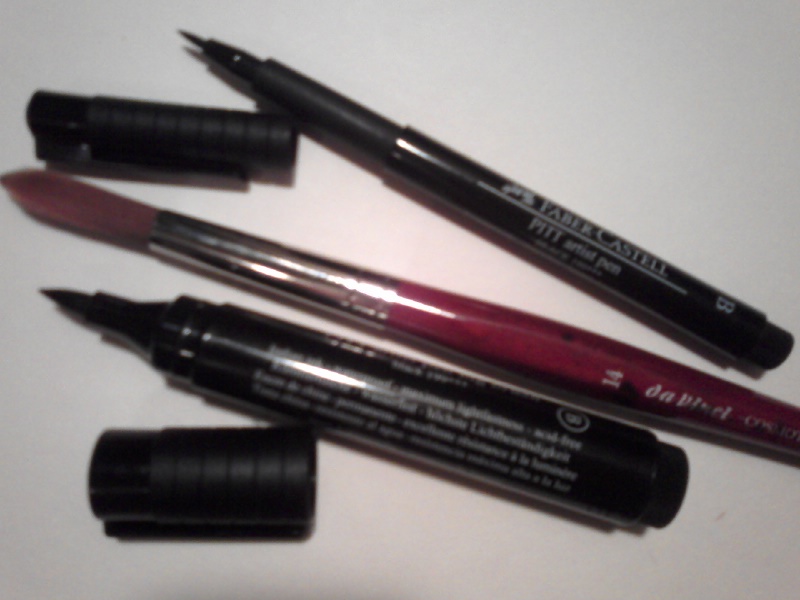
That paint brush in there is a synthetic watercolor brush; the clerk at the local Daniel Smith art supply superstore said it was one of the "better" synthetic brushes, meaning that it holds water and pigment well and distributes them evenly, rather than just shooting everything out onto the paper the moment you touch it; the real nice brushes that aren't supposed to have that problem at all are made from animal hairs, but they are also way more expensive. ;_; So I got four of these "da Vinci" synthetic ones at various sizes, but they still do drop too much fluid all at once, leaving you with an initial puddle followed by a dried, scuffed line; some of them even sort of skip off the paper entirely if you try flexing them down in a particular way. Blah.
The big one is okay for filling large spaces, but I'm going to have to go back to the store and pony up the $30 or so for that apparent Holy Grail of inking brushes, the Winsor & Newton Series 7 Kolinsky Sable Brush, size 3, the official brush of Queen Victoria or something. I learned about it from this video of Doug TenNapel talking about his inking; TenNapel has a copious inking style, which you can see in his recently completed Ratfist comic. But apparently that brush has also been the favorite of many print comic artists.
I'm just hoping I'll be able to make nice lines with it, since I couldn't really with the synthetic brushes. So after a bunch of awful brush sketches which are too horrible to show you, I went back to using the large Pitt brush pen for lines, but something else for most of the shading:

So in that one ^, except for the back of the neck, the interior of the ear, and that patch in the upper right, the grays--and the big messy black mass on the right side, for that matter--are ink wash, which is basically water mixed into India ink, which is basically water and lampblack, which is soot, which is carbon. Whew! I haven't looked into it too heavily, but "India ink" appears to be a contested title and implied attribution; people in China were using black ink derived from soot back in the third millennium BC, whereas in India it only goes back to the fourth century or so BC. I suspect we have the British to blame for the name of it (although apparently they call it "Indian ink"; I wonder if non-native Americans felt that would give too much credit to Native Americans or something ;P); the translation of the name on the huge bottle I got renders it as more or less "Chinese Ink" in Spanish and French. Hm!
The Pitt pens also use India ink, so they seem to work pretty well in conjunction with the wash.
|
·····
|
| |
| Playing with markers | Sep 28, 2011 3:20 AM PDT | url |
| | |
Added 1 new A* page:
^ That is a crappy cell phone photo of pretty much the first ever traditional media A* artwork; I raced across town to the big art supply store on the weekend and grabbed a couple Faber-Castell "Pitt" brush pens (black: a big one and a small one), a couple Copic markers (Neutral Gray 2 & 4!), and a Staedtler white "Mars plastic" eraser. Armed with those, a 9"x12" sketchbook I dug up recently that I've had since at least my art major days in college (I graduated in '96 :o), and a mechanical pencil even older than that (I've had that baby since at least high school--don't think I've used it much since then), I plunked myself down on my apartment's ancient brown shag and tried to draw; that Selenis drawing is what came out.
I've been lusting after brush pens for a while! They're pretty fun--nice dark India ink. The Pitts are *pretty* fluid, although I certainly wouldn't mind if they were a bit wetter. Still, I think I will have uses for these in the future.
Copic markers are all the rage among a lot of comic (web and print) pros and amateurs, and they seem nice for what they are, but I don't think markers are my thing. Too slow! They're drier than the Pitts, so you have to move them pretty slowly if you want to get color or value down evenly. I don't like moving slow, as you can see by my completely improper and fairly ineffective use of them in that drawing. They got some gray in, which is what I wanted, but I don't think I'll go with markers for that in the future.
To which end I have some other traditional media toys now that I am going to go play with, since I was encouraged by this fairly successful (by my lights) first attempt with the markers and pens. Hopefully I will be able to show you another new non-computer-art A* thing tomorrow!
Oh! But if you would like to have this FIRST EVER A* non-computer drawing (and my first and probably last marker drawing :o) for your very own, I could be convinced to part with it for eh let's say $50. Plus $5 or $10 or whatever insured Priority Mail shipping will be, I gotta check on that. Anyway if you want it, just PM me on the A* forum, on Twitter, or on deviantART, and I'll get that worked out for you--first come, first served, of course, since there's only one. :o
Oh! #2! The paper is actually not like flesh-colored on her face there, that is some funky trick of the lighting and camera. The paper is more or less white, although I think (all my interior lights here are warm--don't have one of those expensive "full spectrum" lights they have these days :P...I work in black and white for gosh sakes!) it may be *slightly* tinted toward the yellow after all these years. I got it back before "acid free" and "archival" were all the rage in art paper. :P
Ooh, and I'll get an actual quality reproduction of it posted once the large-format scanner I ordered arrives--tracking says tomorrow! :o Whee I'm kind of excited to (nearly) have a scanner again, even though they take up a heck of a lot of space in my teeny little apartment.
EDIT: It occurs to me that this is probably the first non-total-doodle drawing I've tried doing without a computer in...um...uh...over a decade? Quite some time, anyway. Was relieved to find that the computer hadn't *totally* atrophied me when it comes to trying material art.
|
·····
|
| |
| One if by land, two if by robot | Sep 27, 2011 4:41 AM PDT | url |
| | |
Added 1 new A* page:I did some costume studies for the end of this episode (which we are now pretty much into) over the weekend:



And then my wrist was hurting a little and I drew a sad clown. >_>

If you follow A* on Twitter or on Facebook you probably knew about those days ago! *hint* *hint* Oh except the clown one, I saved that for just now. :P
These arty things can be found at any time in the episodes > episode 13 > gallery page accessible from the site's top menu.
~~~~~~~~~
What with a dinner party, art show stuff, and some secret things I shall begin to reveal perhaps tomorrow--oh and I have to do laundry! :o--this week is looking a little crazy. So I got just the one page done today--that may happen more often than not this week, I think--and it has some oddities I thought I'd confess to:
··· That space sky view behind Selenis is not a view through a transparent dome or something, but rather a fancy 3D-like (although it's actually more like one of those little optical illusion things you can tilt back and forth and seem to rotate the view of the pictured object--except with this thing there would be like hundreds of viewing angles rather than just a couple) projection or display on the inside of this pressurized dome they have driven into. That's because a clear view of space near the galactic center would mean you were exposing yourself to more cosmic radiation than would be wholesome; Selenis has done that before with her clear helmet, but she sometimes likes to live on the edge, you know.
··· Similarly, these cars don't have actual see-through windows. And for safety purposes--in case one of the areas they're driving through has an accident and depressurizes--they'd need to be capable of sustaining a fully pressurized interior.
··· Selenis is getting out of what I think will be shown later to be the driver's seat on this planet. So eh either she drove this fancy car from the spaceport herself, or it's a robot car that just goes where it's told. YOU DECIDE! :O (But if you decide it's a robot car, you also have to give it a name. :p)
··· Selenis is dressed like um Paul Revere or something. I am not really sure why; I just wanted a sexy yet classy yet ultramodern business look, and apparently neo-American Revolutionary War costume is what that adds up to in my subconscious. Notice that I hadn't thought to do a costume study for this over the weekend--that probably would have helped. :PP
|
·····
|
| |
| Storyboards, my fickle friends | Sep 24, 2011 2:26 AM PDT | url |
| | |
Added 1 new A* page:Just got the one page done today because, well, it was Friday. :P
We're entering the final act of this episode here, and it will be pretty much all what they used to call a "dumb show," back when "dumb" meant "mute" rather than "stupid." But it will be up to you to decide! If I do it right it should be kind of intense. :o
Now that I'm (mostly) going to be doing two pages a day, I'll be churning through my storyboards twice as fast, and I'm currently out of storyboards, so...yeah, I really need to get on that. Hopefully I'll be able to sneak them in here and there and keep a few days ahead on those. Here's the storyboard for the previous page, which I kind of liked on its own--they usually come out a lot less legibly than this, if you can believe it:

What else should I lay on you here... Oh yeah, stay tuned Sunday for a new page of my fairy tale comic, "The Princess and the Giant"--which is also entering a new phase of its story, come to think of it. Here's a spiffy link/banner/teaser for last week's page to get you caught up:

And eh since I put my other daily comic, Sketchy, on hold to be able to get two A* pages done a day, now isn't a bad time to rampage through that comic's silly archive, if you need to waste more time on the internet and are out of other ideas! It sort of cuts off in the middle of the latest story I was doing in it, but if you want to catch a complete story, the "Tale of Death Boy" starts here.
|
·····
|
| |
| Watching YouTube through someone else's brain | Sep 23, 2011 5:21 AM PDT | url |
| | |
Added 2 new A* pages:Whew, two pages. *huff* *puff*
I accidentally ran across some neat science stuff happening, so I guess I'd better get 'em out:
- NASA's Upper Atmosphere Research Satellite, launched in 1991 and operational, at least in part, until 2005 (and the International Space Station had to dodge it in 2010!), will probably be crashing down to Earth in 26 or so chunks tomorrow. Up to 300 pounds each, the chunks are expected to hit an ocean, and apparently have almost no chance of coming down in North America; NASA calculates the chances of them hitting a human as 1 in 3,200. Old satellites inevitably fall out of orbit, due to heating or atmospheric friction or something slowing them over time, and generally they're supposed to be designed so that they burn up neatly in the atmosphere as they fall, but a--I think--recent re-evaluation of this satellite showed that major parts of its construction would in fact withstand atmospheric re-entry. Oops! Hopefully it doesn't hit anyone; if it does, it will be only the second time anyone's ever been hit by falling space debris: "The only confirmed case of a person being hit by space junk was in 1997 when Lottie Williams of Tulsa, Okla., was grazed in the shoulder by a small bit of debris from a discarded piece of a Delta rocket."
- Putting a bit more egg on NASA's face, Neil Armstrong has just called the US space program "embarrassing"; he doesn't like that we don't have a manned space flight mission now that the Shuttles are retired, and we have to rely on other countries--and possibly private companies, in the future--to do something like support the International Space Station, in which we have a major investment.
- A recent study--I think by the University of California, Berkeley--has managed to reconstruct images directly from peoples' brains using "functional" MRI technology ("fMRI") to read their brain activity, and then complex computer programs to take that data and convert it back into visual images. The subjects were strapped into fMRI machines, made to fix their eyes on a very specific location, and were then shown a selection of 18 million one-second YouTube video clips. :o Here are some of the reconstructions, fittingly enough in YouTube format:
video on Youtube
Maybe I'm a pessimist, but I think some of those "matches" are not the same scene as the one the computer thought they were matching. And this sort of thing has been done before: as I mentioned back in June, in 1999 a similar procedure was performed with cats, and in 2008, a Japanese team achieved it with humans. That 2008 experiment produced only 10x10 black and white images from the fMRI data, though, so this new experiment has advanced the visual quality of the results considerably.
It isn't reading thoughts or anything like that--just visual sensory data coming directly from the eyes into the brain--but in A*'s story, Selenis' neural implants do something similar (in much higher fidelity, mind you!), so...neat!
- A team of French and Italian scientists working at CERN claim to have clocked a beam of neutrinos they fired from a particle accelerator near Geneva to a lab 454 miles (730 km) away in Italy as having covered that distance "60 nanoseconds faster than the speed of light"; a nanosecond is a billionth of a second, and the speed of light (in a vacuum) is 300,000 km/s, or 0.0003 km/ns, so that means I guess that the neutrinos arrived in just 0.0024332733 seconds, rather than the 0.0024333333 seconds that light should have taken--although hopefully they were adjusting for altitude, air pressure, gravity, and so forth. Needless to say, the experiment's results and conclusion--that neutrinos travel faster than light--is being taken with quite a bit of skepticism, in large part because the idea that nothing travels faster than light is pretty much the foundation of modern physics, or something like that. Also, since the speed of light can vary depending on what it is moving through, I wonder if they fired a beam of light alongside the neutrinos, as a control--the article doesn't say. And I'm pretty sure that neutrino bursts from things like supernova explosions in space have been timed alongside visible light from the same source before and have not been found to be faster, except in that they get a bit of a jump start since they can move directly through all the material in the collapsing star, whereas the photons have to wait until the surrounding material disintegrates before they can escape; that's the principle behind the Supernova Early Warning System, in fact. Nothing like a theory-shattering claim to stir up some good science drama, though. :P
|
·····
|
| |
| How's about two A* pages a day? | Sep 22, 2011 5:18 AM PDT | url |
| | |
Added 1 new A* page:I'm going to try to go back to doing two A* pages a day.
That will probably mean one in the evening and one in what will technically be the morning of the next day. I'll post a link to every new page on Facebook and on Twitter as soon as each one goes up, so follow me on one of those if you'd like to get notification immediately when there's a new page! Or you could just reload the front page of the site every few hours, I don't mind. :D
I'll probably only manage one page on most Fridays, since that's the one evening of the week when I peel myself off the computer and go hang out with my poor neglected friends. And if you were following the comic back when I was doing two pages a day before (that was prior to this latest episode, more or less), you'll know that there will just be days here and there where something will come up and I'll only manage page. But still, it should be mostly two pages a day.
I don't want to sacrifice visual quality, but I think I've gotten faster lately--I had to when I switched to a standing desk mid-episode, because I couldn't stand and draw for very long! :o--so I think I have a shot at pulling this off semi-decently. And there's a certain brisk energy my two-a-day pages sometimes had that my one-a-day pages are sometimes lacking, if that makes sense. And I worry less about the pacing if I can get two pages done a day; with just one a day, I feel much less comfortable doing sort of dramatic pauses and glances and all that--which are things I really want to be able to do; I've already found myself cutting pages a few times in this episode to move things along, and I don't like doing that.
I haven't got *that* much faster at drawing, though, and I don't want to feel *too* rushed and sloppy as I try to get two pages out, so I'm going to have to cut down on a few non-A*-comic things I've been doing.
For one thing, I'm pausing what had been my other daily comic, Sketchy. It's a nice warm-up each day and I do have some fun with it, but even drawing it as hastily as possible, it still takes a measurable chunk of each work day--and while there are maybe a few dozen really lovely people who follow it (thank you!!!), A* has at least 100 times more readers, so Sketchy is looking like a not-all-that-clever use of my time. Alas, poor Sketchy!
I also probably won't have nearly as many lengthy semi science/research blog entries, since those actually take quite a bit of time to prepare. I'll miss doing that, because I really do enjoy looking into interesting space science things or whatever, and posting nice big cool photos of them, but I'm pretty sure 99% of A* readers are here primarily--or even exclusively--for the comic, so that's probably what I should concentrate on.
It's possible this won't work out at all, in which case I'll happily be able to resurrect Sketchy, and do more in-depth blog articles. But for now I'll be trying this two-a-day thing again.
~~~~~~~~~
And I don't have a nice photo sciencey article or new Lance Murdoch (Unqualified Psychoanalyst) comic today 'cause I spent the rest of my time switching the "portfolio" page for my photo-based portraits from a regular old HTML page to a nice tidy script-generated display that will update itself so I don't have to muck with my text editor every time I make a new drawing. It doesn't look any different at the moment--except for being centered--but once it gets more than a certain number of images in there--the default is currently set to 20--it will automatically split them into sorted displays across multiple pages. And that sounds dumb and boring but I'm actually quite pleased with it because split-page lists have always scared me and I'd avoided trying them up until now. =P (If you do want to see the simple split-page listing I'm so inordinately pleased with, you can see it if you set the per-page image limit to something small, like one.)
|
·····
|
| |
| Now accepting Character Art Commissions! | Sep 21, 2011 5:01 AM PDT | url |
| | |
Added 1 new A* page:I'm now accepting Character Art Commissions! (That link is always accessible from the "store" link in the site's top menu.)
Got a beloved character from a movie, book, comic (even A*! :o), or just from your own head? Send me a description and $25 using the simple online form, and I'll draw them just for you, doing whatever you want! The detail level would be something like this:

--although that would just be the small, low-res version I'd add to my portfolio; the person who commissions me gets the full, high-resolution version suitable for making a nice print, wallpaper, or...whatever they want to do with it!
So if you've ever wanted me to draw something that I just haven't drawn yet, this is how you can make me do it. :)
~~~~~~~~
I was encouraged to think of and launch this art commission thing due to the relative success of the $5 photo-based portraits I started offering a few weeks ago. Thanks to everyone who's had me do one for them. :) Here's the latest--it was a pretty fun expression to work from (nice lighting, too!):

The expression, pose, and lighting actually kind of reminded me of this drawing of Vero from A* episode 4. :D
|
·····
|
| |
| Lance Murdoch gets in your head | Sep 20, 2011 1:57 AM PDT | url |
| | |
Added 1 new A* page:Fresh from the pages of my occasional oneoff.smbhax.com humor comic, it's The Continuing Diagnoses of Lance Murdoch, Unqualified Psychoanalyst!
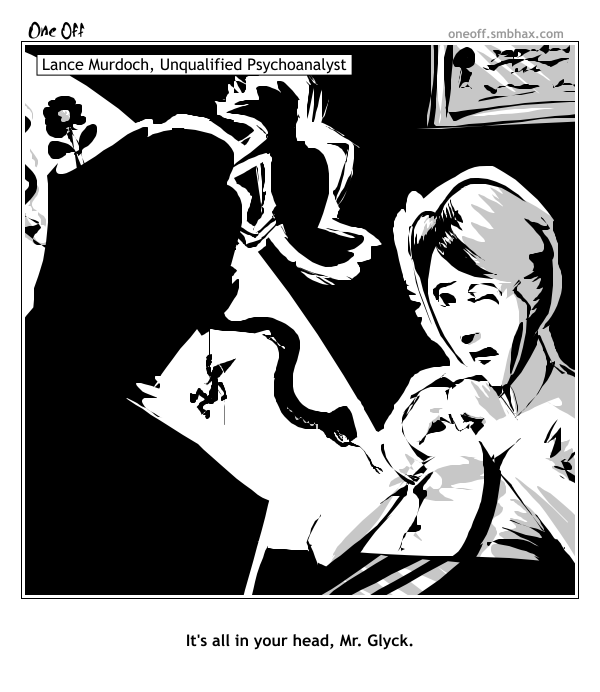
Man I bet that's unoriginal! I was too scared to try Googling it. :o
~~~~~~~~
I was looking up A* on alexa.com (>_>) and found some other sites have linked to me that I didn't know about! And because I love love looove it (but really, I do like it) when people link to me, I'm going to tell you about them!
- Eh well three sites, even one in Japanese, linked images of Chernobyl that I posted back in these news articles.
- The blog "A Bureaucracy of One" wrote some nice things about A* (this was back when I was fresh off meeting Phil Foglio and was more or less off my head because he'd said he read A* :o...and yes I am still name-dropping that almost a year later :PP).
- Poster RGE linked to A* from a comment on an interesting comic-style animated "explanation" of "dark matter" here on the blog "krazy kimchi."
- Poster Versatek6 included A* in a linked list of webcomics in a post on this Twilight Lady webcomic page.
- Someone cool put a nice little banner link to my Sunday Princess and the Giant comic up on the Comics page of Kymation.com.
- The author of Forsaken Stars (which is a pretty interesting black and white sci-fi webcomic) linked to the Princess from this list of webcomic nominations in a blog entry on his site.
- Anna Moritz's Photo Blog has a "gallery" link (warning: high bandwidth) to the "Journey into a black hole" thread on the A* forum, where there are a lot of neat space pictures I've posted before.
~~~~~~~~
Oh and I happened across this interesting radiation dose chart by Randall Munroe, who does a little webcomic you may have heard of called "xkcd." The chart gives a visual idea of the scales of radiation exposures, ranging from what you get from sleeping next to someone (:o), through things like a chest X-ray, exposure in various places at Chernobyl and Fukushima, all the way up to the fatal dose amount. It's a little hard to read all at once since it sort of "zooms out" like three times, but it puts things in an interesting perspective nonetheless.
|
·····
|
| |
| Is Sgr A* blowing Fermi bubbles? | Sep 17, 2011 5:26 AM PDT | url |
| | |
Added 1 new A* page:Well I'm going to do some science bloggertry today rather than another Lance Murdoch, Unqualified Psychoanalyst comic, because it's late, and it's the weekend, darn it. Although I will be doing my weekend comic, The Princess and the Giant, this Sunday, and oh gosh look here's a teaser/link to last week's page just in case you missed it:

~~~~~~~~
Oh yeah, part of the reason it's so late as I write this is because today's A* page was a fussy one. For instance, here are various attempts at layouts/finishes for just this page:

And that's not even taking my various shading attempts into account! Dar!
~~~~~~~~
When I was looking up the Fermi Gamma-ray Space Telescope the other day--that's the orbiting instrument that made that all-sky map of various pulsars--I came across something somewhat mind-blowing AND directly A*-related! It seems that a year or so ago, some folks at NASA or wherever were taking that sky map of gamma ray emissions and basically Photoshopping it in various ways to see if they could find interesting structures or patterns that weren't immediately obvious, and they came up with this:
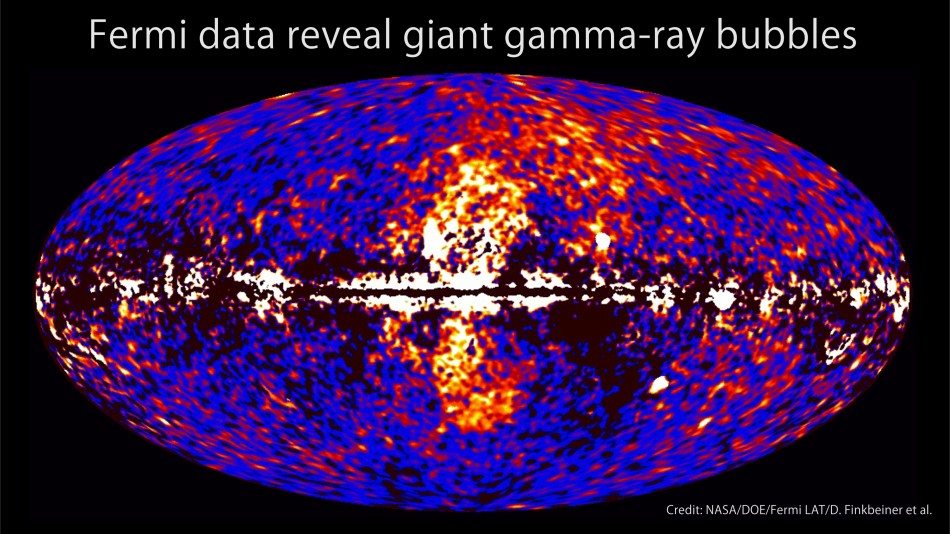
image by NASA/DOE/Fermi LAT/D. Finkbeiner et al. (source)
in which, you'll notice, two gigantic, bulbous gamma-ray emitting lobes appear above and below the galactic center. Extrapolating from that data, what they came up with was this (artist's interpretation):
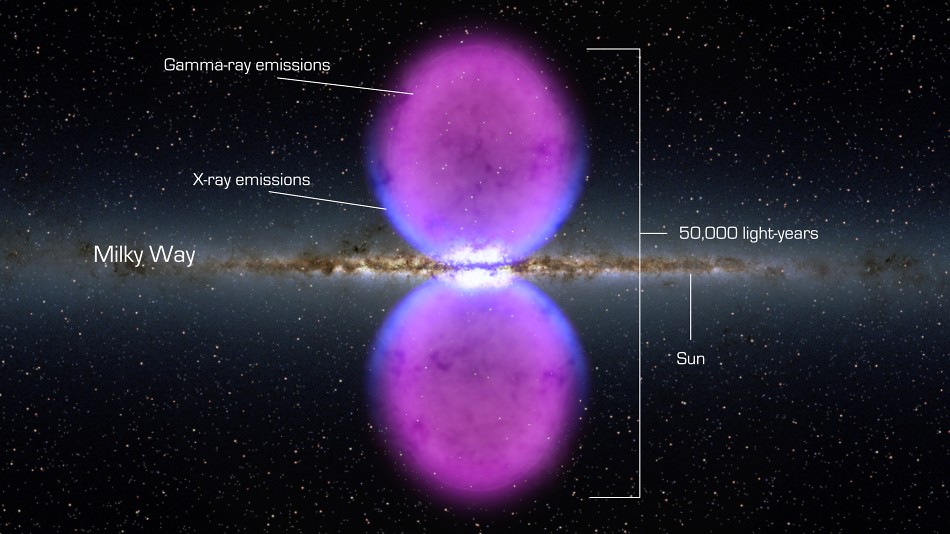
image by NASA (source)
They call them Fermi bubbles, and they are areas 25,000 light years tall (that's the same distance from Earth to A* at the galactic center, by the way!), radiating out in elongated spherical shapes from approximately the top and bottom of supermassive black hole Sagittarius A* at the center of the Milky Way. The gamma rays they're emitting come from collisions of highly energetic electrons with low-energy photons (radio and infrared light).
They don't know what generated these structures, but it seems likely to have had something to do with A*--possibly from huge jets of energy thrown out from the poles of the supermassive black hole millions of years ago, when it was feeding on a lot of material swirling into the center of the galaxy. And the curving shapes of the lobes make me wonder if those particles are still trapped in magnetic field lines anchored on the black hole.
|
·····
|
| |
| Lance Murdoch, Unqualified Psychoanalyst | Sep 16, 2011 2:24 AM PDT | url |
| | |
Added 1 new A* page:As I lay in bed this morning trying to get back to sleep, a new vein of humor comics popped into my head. And I want to get them out, but I don't seem to manage to have time to do a Sketchy comic, A* comic, A* sciencey blog thing, AND one of these other comics every day. So the blog, being the weak link there, will be switching gears for a bit as I get these gag comics done. They'll be compiled in my One Off humor comic site, but I'm also going to put them in the A* blog because eh otherwise I won't have much put here! Also, their pseudoscience may provide a nice contrast to A*'s attempts at hard science. AND they'll be giving me additional drawing practice with the Lasso Tool technique I use on A*, which can only be a good thing for this comic.
So anyway, I give you the first in a little series I'm calling The Irresponsible Diagnoses of Lance Murdoch, Unqualified Psychoanalyst:

Yay! Okay but I am going to sneak in some quick science bits today:
- Generally I try to avoid posting about extrasolar planets people are discovering these days, because there are so many of them, and because the conclusions reached about their size and surface conditions and so forth are generally based on very, very scanty data. But anyway, I thought it was interesting that NASA's Kepler mission has just announced the discovery of the first known planet to orbit two stars; apparently a planet orbiting a binary star like this is called a "circumbinary planet"; and this one, although its current official designation is Kepler-16b, appears to have been nicknamed "Tatooine" already, after the planet in the Star Wars movies that had two suns in its sky.
- NASA has just come out with the plans and proposed budget for their new rocket, the one that would be used to go to Mars and so forth. The really boringly named "Space Launch System" (although I guess "SLS" sounds okay) will/would be somewhat larger even than the huge Saturn V rockets used in the Apollo program (the one that sent people to the Moon), and the program to develop and launch this massive liquid hydrogen & liquid oxygen-powered astronaut-launcher would cost about $35 billion. If, that is, Congress approves it, which... Well, I guess we'll see how that goes.
- And that reminded me of this article I noticed back in May (and which has been wasting away at the bottom of my large blog topic backlog all this time :p) about the crew vehicle that would be launched on the SLS, namely the "Multi-Purpose Crew Vehicle (MPCV)" (ew, now that name is just dull no matter how you slice it--unless I suppose you stick "Orion" on the front of it, which people seem to have started doing--it was originally going to be part of the proposed "Orion" spacecraft "in the now-cancelled Constellation program"); it's supposed to be about twice as roomy as the capsules used back in the Apollo program, so it could carry six astronauts, rather than just three. (Although I'd think it might be nice to carry just three astronauts, but give them more breathing space for these much longer proposed space flights.)
- And here's a video showing what might be a "fireball"--that's the official name for a basketball-sized asteroid that smacks into Earth's atmosphere and leaves a blazing trail across the sky as it disintegrates. This one was widely seen in the sky in the American Southwest in the past day or so.
|
·····
|
| |
| Of pulsar maps, golden records, and apple pie | Sep 15, 2011 1:26 AM PDT | url |
| | |
Added 1 new A* page:I was talking about pulsars yesterday, and one thing I mentioned was that they lose their rotational energy and magnetically powered jets after "just" 10 to 100 million years. But that relatively short life-span in astronomical terms didn't deter NASA from using pulsars to illustrate Earth's position on plaques and records that went out on the Pioneer and Voyager probes in the 70's, respectively. Designed by Carl Sagan and Frank Drake, the diagram of 14 pulsars around the Earth (in the lower left of the image below) could theoretically be used by someone really smart and determined to locate Earth in this part of the Galaxy:
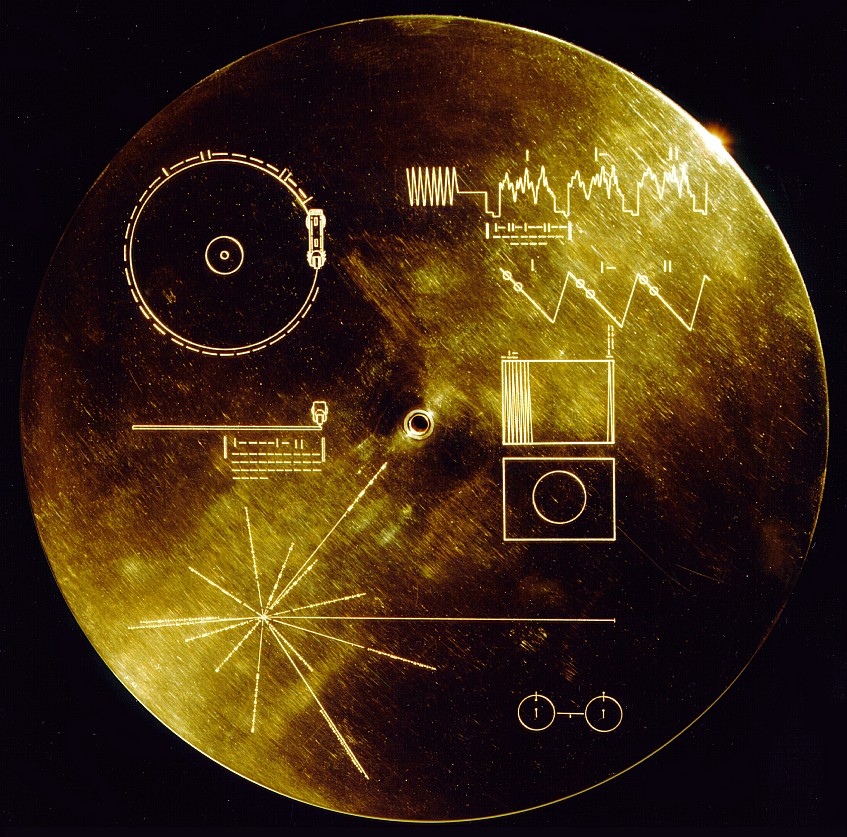
image by NASA (source)
The dashes along the lines pointing to the pulsars is their frequency in binary code, in time units of the spin-flip transition of neutral hydrogen (the frequency at which the spin quantum mechanical property of hydrogen atoms changes, which is illustrated to the right of the pulsar map); the length of the line is their relative distance (although if they'd wanted to be really clever they'd have somehow shown that in units of spin-flip frequency length...), and "tick marks" at the end of each line are supposed to show the pulsar's Z coordinate relative to the galactic plane. Pshew! They'd have to be pretty smart aliens to figure all that out--and to line it up with whatever they could see of some of those pulsars from wherever they are--but hey, we only want the smart aliens coming here, I suppose.
That was printed on the inside and outside of the cover (since the outside might get dinged up by micrometeorites, etc) of the Golden Records included on the Voyager probes. The diagrams above the pulsar map are supposed to show a very smart person how to make a machine that would play back the data on the record, which contained "116 images and a variety of natural sounds, such as those made by surf, wind, and thunder, and animal sounds, including the songs of birds and whales" and "musical selections from different cultures and eras, spoken greetings in fifty-five languages, and printed messages from President Jimmy Carter and U.N. Secretary-General Kurt Waldheim."
The diagrams really embody both Sagan's positive belief in the existence of intelligent life in other parts of the galaxy, and his sort of constructivist approach to science, where he liked to start with basic principles and build up from there. This is best embodied, I think, in his story of how to make an apple pie, as heard in this catchy remix:
video on Youtube
Here's what the record itself looks like:
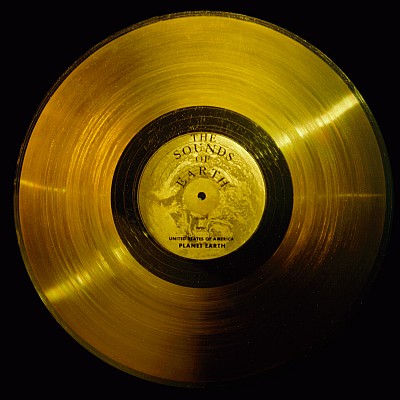
image by NASA (source)
Despite the popular name it has gained, the record was mostly non-gold: "The record is constructed of gold-plated copper. The record's cover is aluminium and electroplated upon it is an ultra-pure sample of the isotope uranium-238. Uranium-238 has a half-life of 4.51 billion years. It is possible that a civilization that encounters the record will be able to use the ratio of remaining uranium to daughter elements to determine the age of the record."
I'd say if they can figure out the pulsar bit, the uranium puzzle should be...easy as pie! =p
|
·····
|
| |
| Zodiacal light, pulsars, and magnetars again | Sep 14, 2011 2:56 AM PDT | url |
| | |
Added 1 new A* page:I haven't done one of these in a while, and today's page drawing went pretty smoothly (unlike, say, yesterday's--*shudder*), so here's a little animation of some steps it took in the process from really shaky storyboard (my secret shame: I never finished getting all the storyboards for this episode done, so I had to get back on that today; this was the first and it was a wee bit scratchy) to the finished art with three shading layers:

~~~~~~~~
I dunno if you watched all of the BBC video I linked yesterday showing their 2011 Astronomy Photographer of the Year contest winners, but it brought up some pretty interesting subjects that I just had to go look up!
I thought the zodiacal light photo was interesting: zodiacal light is a column of faint, very diffuse light sometimes visible in the night sky, mostly just after sunset or just before sunrise--it's due to sunlight scattering off cosmic dust in the interplanetary dust cloud, a disk of dust that extends well out past the orbit of Earth; although cosmic dust (including stardust, which is a specific type) mostly forms in the atmospheres of stars, because such dust can only float around the star for about 100 million years before it is thrown out of the system or merged into some larger body, all the dust currently in our solar system is "later generation" dust from comets, asteroids, and so forth. Here's a different photo of zodiacal light seen from Paranal, mountain site of the observatory by that name in Chile, with its famous Very Large Telescope:
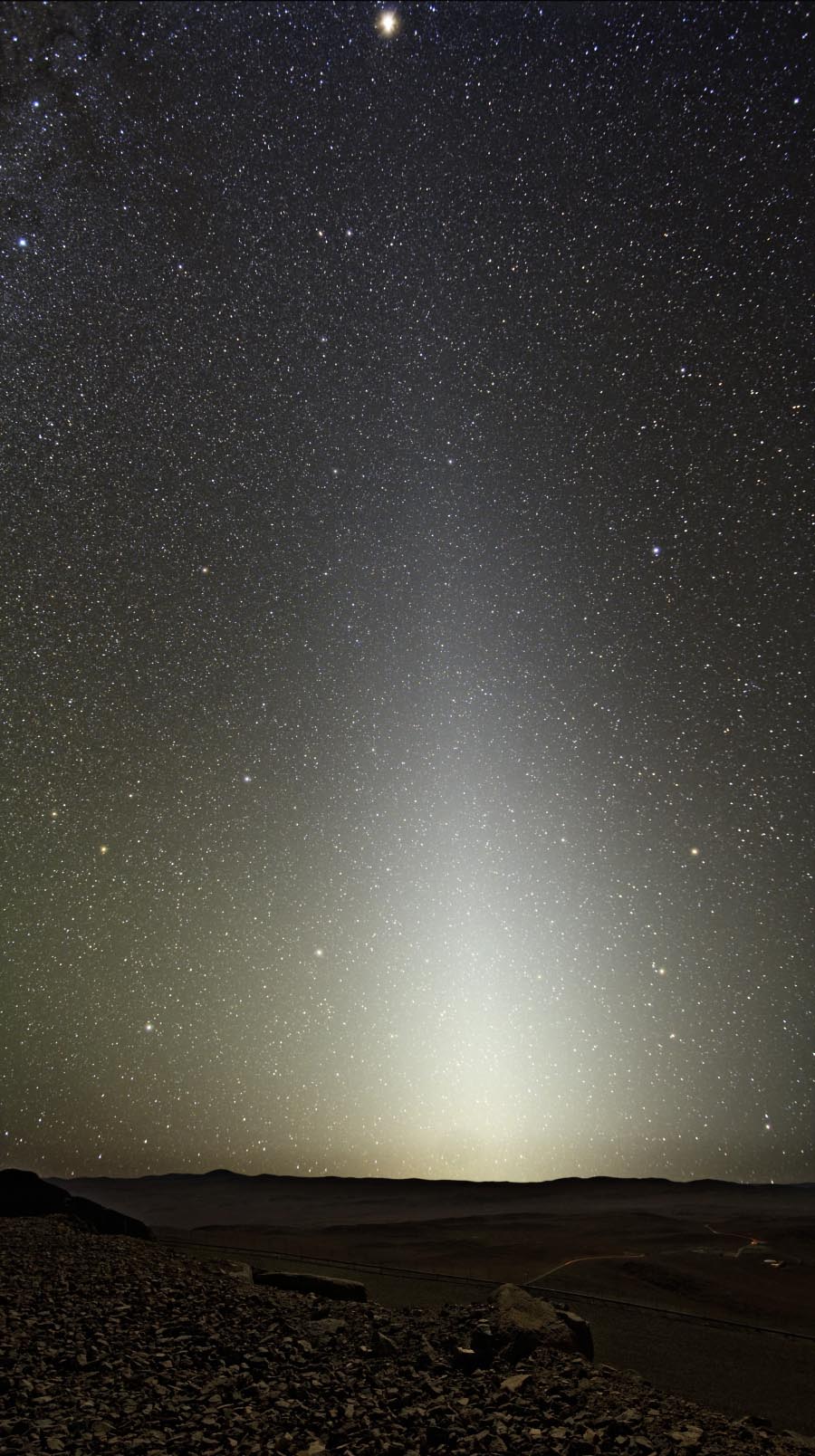
image by ESO/Y.Beletsky (source)
And although it mostly looks like a column, "in fact, the zodiacal light covers the entire sky, being responsible for 60% of the total skylight on a moonless night." And here you thought it was all from stars!
The winning BBC photo of the Vela Supernova Remnant is also really neat; from a supernova that exploded around 12,000 years ago, at 800 light years it is one of the closest supernova remnants to Earth, and one of the brightest X-ray sources in the sky. There's a really nice photo of the whispy, bubbly, ghost-like remnant over here. But the reason it's one of the brightest X-ray sources is because the core of that supernova survived to become a neutron star, the Vela Pulsar.
The Vela Pulsar is historically significant because its connection, made in 1968, with the surrounding supernova fragment, provided the first real evidence that supernovae form neutron stars. It is called a pulsar because it still has a lot of rotational and electrical energy from the supernova, which has left it spinning rapidly; this forms a very powerful magnetic field that shoots material and particles from the poles of the neutron star's magnetic axis, which is offset from its rotational axis, so emitted beams carves very rapid paths across the heavens; the Earth happens to be in one of those paths, so we see high-energy emissions from it in a series of steady, rapid pulses--the Vela Pulsar is "the brightest persistent object in the high energy gamma ray sky," sending gamma rays our way, some of which (keep in mind these are individual photons) carry energy over one billion electron volts (those rank as third overall in terms of bright gamma ray sources in the sky); "for comparison, visible light has energies between two and three electron volts." Here's a nifty animation of Vela's gamma ray pulses:
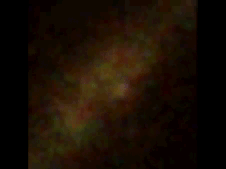
image by Roger Romani (Stanford University) (Lead), Lucas Guillemot (CENBG), Francis Reddy (SPSYS) (source)
This Chandra X-ray image shows the superheated gas caught in the pulsar's electromagnetic vortex; it's shooting out along one of the jets in the upper right, but as you can see follows a twirling path down the length of the magnetic line, rather than moving straight:
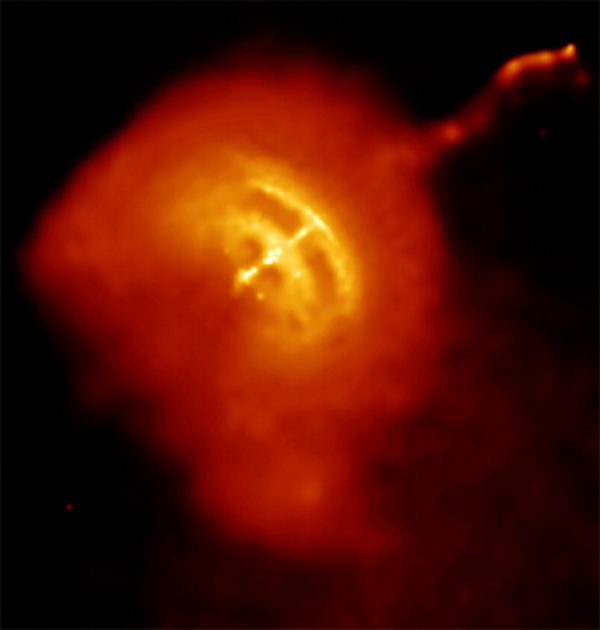
image by NASA/CXC/PSU/G.Pavlov et al. (source)
Multiple Chandra images have been combined into a slow animation of the gas in that jet; globs of gas moving along the jet have been clocked at about 50% light speed!
Being that bright from 959 light years away, Vela is powerful, but the closest neutron star to Earth is the rather unfortunately named Geminga, which is 815 light years away. Geminga (the name is supposed to mean things in two languages, which was rather too clever as it sounds really silly in at least one of them) was born from a supernova 300,000 years ago, and that supernova may have been the event responsible for blowing the Local Bubble in which our Solar System resides: a 300-light-year cavity in which space is only about 10% as dense (averaging "0.05 atoms per cubic centimetre") as it is in the rest of the galaxy as a whole. Geminga might also have got a lot of velocity from the explosion, as it is zipping through space at about 205 kilometers per second (about 2/3rds of 0.1% of the speed of light)--which explains why the source of our 300-light-year bubble is now over 800 light years away (although if you do the straight math on that (205 km/s * 300,000 years) it would be more like 194 light years away from the source of its detonation, but I suppose it has probably slowed a bit, and the bubble and Earth for that matter are probably also moving in various directions relative to it anyway).
Pulsars gradually run down, losing their rotational energy and thus their magnetic jets after just 10 to 100 million years, which means that 99% of the neutron stars in the Milky Way have spun down to the point where they no longer pulsate.
Here's a neat map of the sky by the Fermi Gamma-ray Space Telescope showing the positions of the Vela and Geminga pulsars, among others:
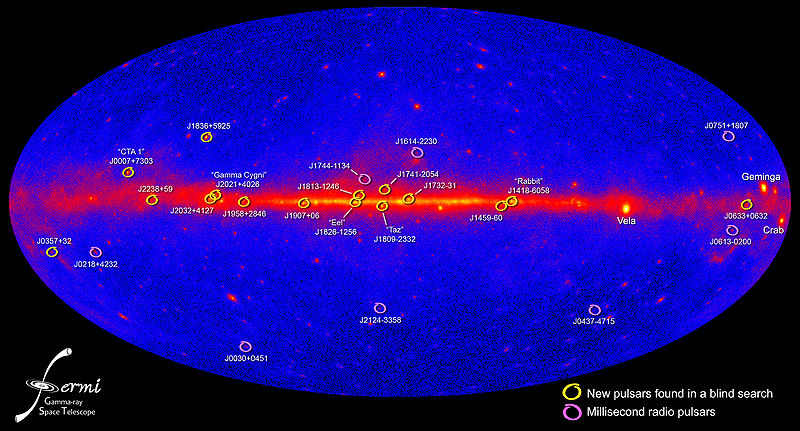
image by NASA/DOE/Fermi LAT Collaboration (source)
And I am just going to mention another that *isn't* on there: SGR 1806-20 ("SGR" stands for "Soft Gamma Repeater"; its pulsar identifier on the map would have been "PSR J1808-2024"), a magnetar, which is a name used to identify neutron stars with particularly strong magnetic fields. I've talked about magnetars before; I'm just throwing SGR 1806-20 in here because speaking of those strong gamma rays coming from Vela, SGR 1806-20, which is way farther away--50,000 light years, on the far side of the Milky Way--is responsible for the brightest event every to come to Earth from outside our solar system:
On December 27, 2004, the radiation from an explosion on the surface of SGR 1806-20 reached Earth. In terms of gamma rays the burst was brighter than a full moon and had an absolute magnitude of around −291. It was the brightest event known to have been sighted on this planet from an origin outside our solar system. The gamma rays struck the ionosphere and created more ionization which briefly expanded the ionosphere. The magnetar released more energy in one-tenth of a second (1.3×1039 J) than our sun has released in 100,000 years (4×1026 W × 3.2×1012 s = 1.3×1039 J). Such a burst is thought to be the largest explosion observed by humans in the galaxy since the SN 1604 supernova observed by Johannes Kepler in 1604.
A similar blast within 3 parsecs (10 light years) of Earth would destroy the ozone layer and would be similar to a 12 kt of TNT (50 TJ) nuclear blast at 7.5 km. The nearest known magnetar to earth is 1E 1048.1-5937, located 9,000 light-years away in the constellation Carina. |
Dang! SGR 1806-20 is the most magnetic object known; it is "only" 20 kilometers (12 miles) across, but its magnetic field "is a quadrillion times stronger than that of the Earth."
|
·····
|
| |
| For $5 you too can rock Einstein's hair | Sep 13, 2011 4:30 AM PDT | url |
| | |
Added 1 new A* page:Completed the first A* Portrait today! The customer sent in a nice photo which translated well into a traced-over sketch:

but they also requested that the figure be given Einstein-like hair! :o So I found this nice gallery of Einstein rocking a variety of radical hairstyles, and decided to go with the "Classic Medium Wavy," so

Voila! Who would'a thought you could have that much fun with a $5 sketch? :D
~~~~~~~
I neglected to plead with you to look at my "Princess and the Giant" fairy tale Sunday page from two weeks ago, so I'm going to try to steer you to it now with this tempting banner/link:

~~~~~~~
And just so we don't have a day go by without some science (although we already had Einstein, but hey, bonus), I recently came across the BBC's Astronomy Photographer of the Year 2011 contest, and specifically the video there showing the winning entries. A nice view of the Milky Way (and the supermassive black hole Sagittarius A* hidden somewhere there in the middle!) features among lots of other cool stuff.
|
·····
|
| |
| Herbig-Haro objects, Bok globules--Ay Carina! | Sep 10, 2011 2:44 AM PDT | url |
| | |
Added 1 new A* page:Yesterday I posted a really big picture of the awesome Carina Nebula. That was about as much bandwidth as I thought I should leech from you for one day, but there's plenty more to be seen of the nebula! So today let's zoom in on some pretty spots with the help of Hubblesite's gallery:
A closer (and I *think* true color; the false color version is here) view of the intricate peaks of gas in the star forming region visible in the lower right of the big image above; the gas is being sculpted both by jets from the new stars within, and by the intense radiation coming from super star system HD 93129 and its nearby cluster of bright stars, which are a ways up "above" the peaks (and not visible in this image):
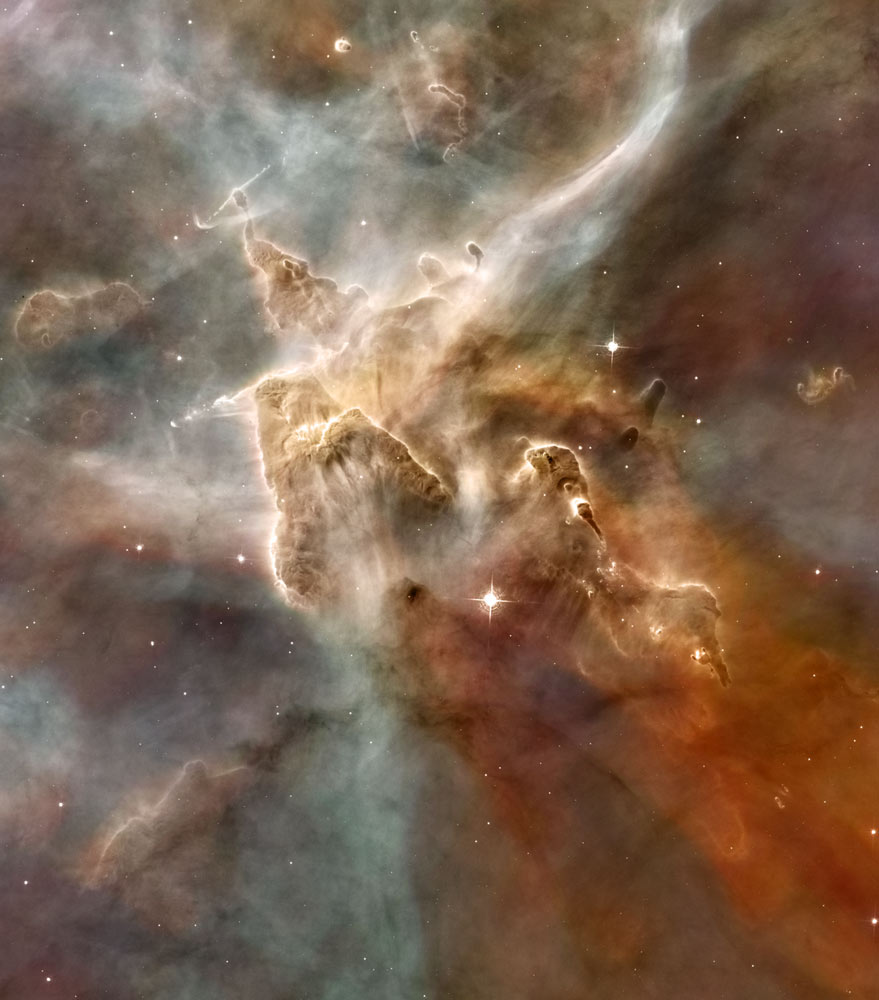
image by NASA, ESA, N. Smith (University of California, Berkeley), and The Hubble Heritage Team (STScI/AURA) (source)
^ The white dashes and arcs coming sideways off the "top" of the peaks in the upper left are caused by jets of material shooting out of the poles of newborn stars at the tips of those peaks as they pull in the material around them (and as that material is driven into them by radiation pressure from the surrounding big stars)--they are "Herbig-Haro" objects, like the ones I showed animations of a week or so ago.
Another neat star-forming region, with gas jetting out from the baby stars forming inside:
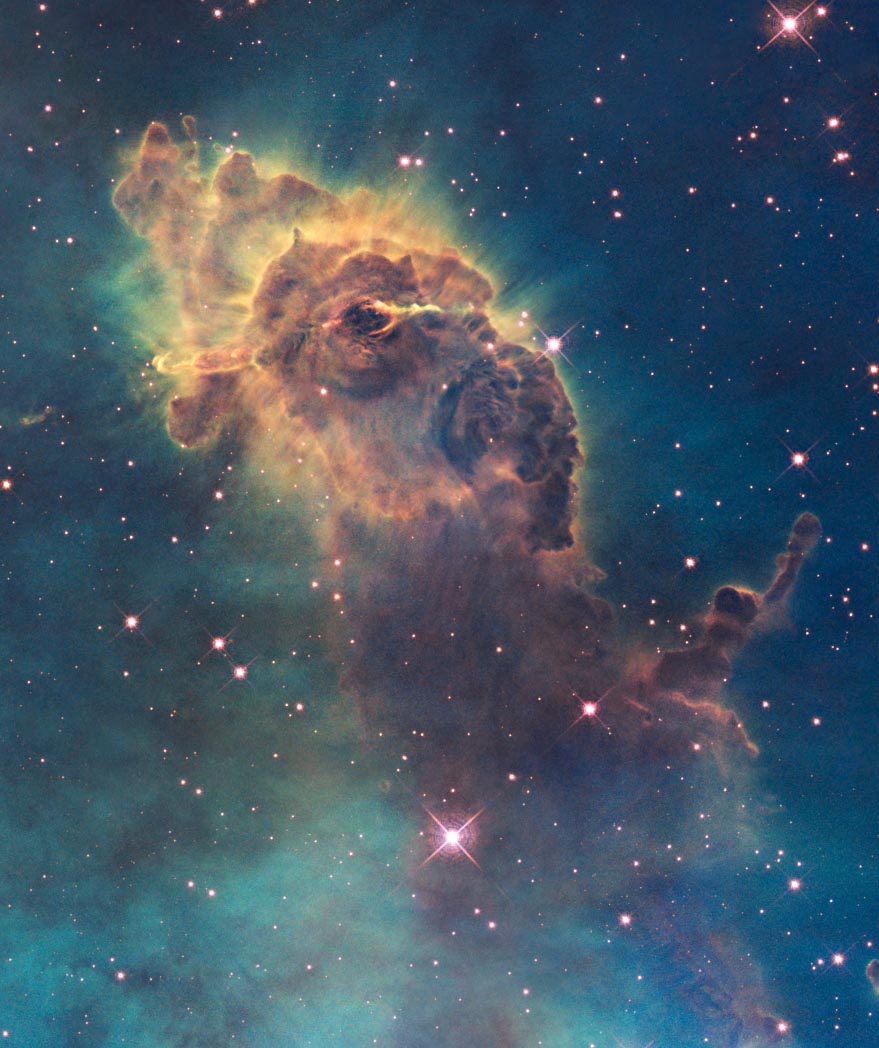
NASA, ESA, and the Hubble SM4 ERO Team (source)
Zoomed way in (that's part of the Keyhole Nebula on the left) on a couple of the tiny, really dense gas clouds visible here and there in the main image; they're called by the unflattering name of Bok globules:
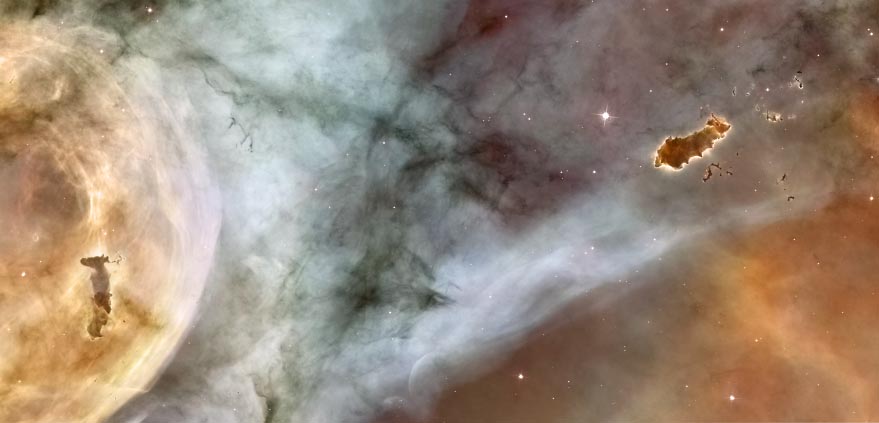
image by NASA, ESA, N. Smith (University of California, Berkeley), and The Hubble Heritage Team (STScI/AURA) (source)
Here we have a pillar of gas and dust sculpted out of and cut off from its main cloud by the intense radiation pressure of the nebula's stars, and, finally getting its due, on the right, hypergiant + supergiant (superhypergiant? hypersupergiant?) binary star HD 93129, with a particularly tiny and eerie Bok globule next to it:
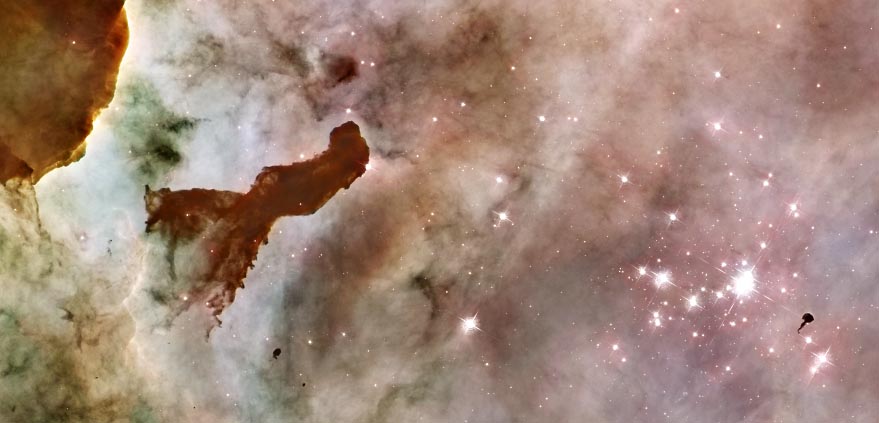
image by NASA, ESA, N. Smith (University of California, Berkeley), and The Hubble Heritage Team (STScI/AURA) (source)
That's one bandwidth-heavy nebula! ;)
|
·····
|
| |
| The Carina Nebula: compelling and rich | Sep 09, 2011 4:38 AM PDT | url |
| | |
Added 1 new A* page:I came across a new AP article today about a child diagnosed with progeria, which has been called an "aging disease"; a genetic disorder caused by a mutation, a baby with progeria will go from having the symptoms of a small, weak newborn more or less straight to the symptoms of a small, weak elderly person; people born with progeria rarely live into their mid-20's.
I hadn't known about progeria before, and I found it interesting in terms of A*, because in order to produce adult clones within the lifetime or near-lifetime of the person cloned, which...well, it saves the story a lot of waiting around, you know, and besides it would be a lot more efficient...anyway you need something Selenis once called "accelerated aging."
Progeria definitely wouldn't be what you would want for that, since it doesn't produce any sort of robust adulthood between birth and death, but it at least shows that one or more of the mechanisms that may be responsible for aging can be sort of sped up. The Wikipedia article on the disorder, which I linked above, says it operates as follows:
The LMNA gene is responsible for producing lamin proteins, which provide strength and stability in cells. Lamin A and Lamin C support the nuclear envelope. When Lamin A is altered, it affects the shape and the function of the nuclear envelope. These changes cause other cells to die prematurely.
Unlike "accelerated aging diseases" (such as Werner's syndrome, Cockayne's syndrome, or xeroderma pigmentosum), progeria is not caused by defective DNA repair. Because these diseases display what are considered different aspects of aging, but never every aspect, they are often called "segmental progerias". |
So in fact there are a whole host of such genetic disorders, prematurely causing various problems usually associated with old age. And there's a name for the scientific field dedicated to studying the biological processes of aging: biogerontology.
Those disorders, though, tend to deal with the, well, negative aspects of aging, rather than what Selenis would be interested in using, namely accelerated bone, muscle, and organ growth, accelerated onset of sexual maturity, etc. And ideally you would want to be able to regulate them a little--once the clone was close to the desired "age," you'd want to put the brakes on a bit. While I don't at the moment know of methods or even disorders that mess with the timing of such biological processes, there must be some sort of biological mechanism(s) controlling their rates, and somehow to me it doesn't seem too far-fetched to think that some day someone--perhaps a somewhat amoral someone, I suppose =p--might be able to manipulate them a bit.
~~~~~~~~~
Anyway that wasn't even what I meant to talk about today, although the main topic is going to involve not so much talk as a big picture, so perhaps it's just as well that I had a wordy but un-illustrated subtopic to partner with it. The bandwidth-heavy topic, then, is the Carina Nebula, home of the huge and somewhat unstable Eta Carinae star system that I was talking about yesterday.
It is a very large and bright nebula, but doesn't grab as many headlines as it should perhaps because you have to be in the southern hemisphere to see it. Fortunately though Hubble can see it for those of us in the wrong hemisphere--and see it quite well, since it's "only" 7,500 or so light years away; I've always liked this false-color mosaic of the whole nebula taken by Hubble, where "red corresponds to sulfur, green to hydrogen, and blue to oxygen emission":
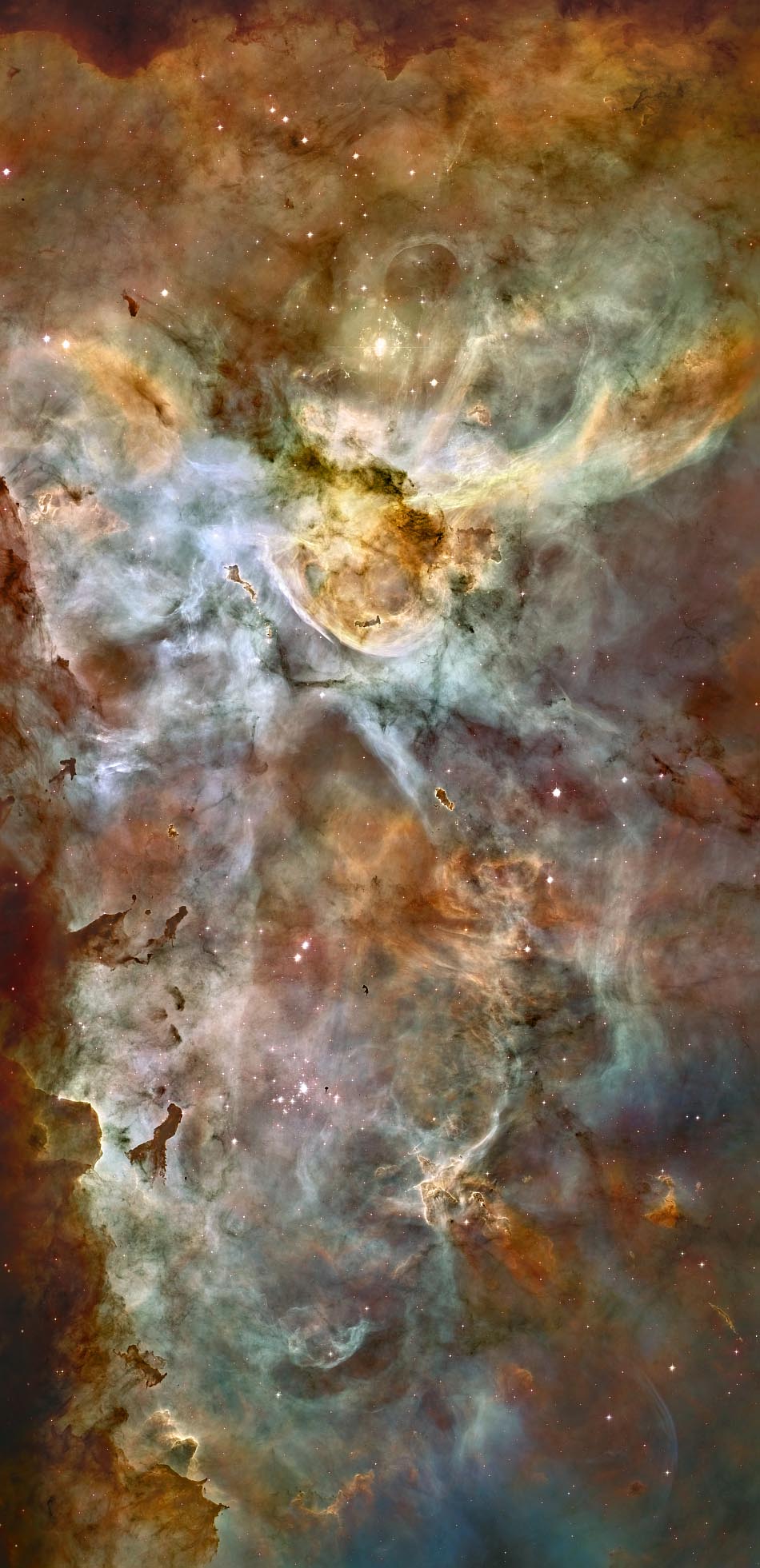
image by NASA, ESA, N. Smith (University of California, Berkeley), and The Hubble Heritage Team (STScI/AURA) (source)
^ That is about 50 light years from top to bottom. Eta Carinae is the really bright star in the middle of the top half. The complicated cloud below it is called the Keyhole Nebula. And the brightest star in that cluster of bright stars in the middle of the bottom half is HD 93129, a binary system which really should have a cooler name, since its component hypergiant and supergiant stars weigh in at a collective 200 solar masses, which is much heftier than Eta Carinae. It has fewer issues and causes less drama, though, so, you know--squeaky wheel and all that. Poor HD 93129 gets no respect, I tell ya!
(Wikipedia has a map of the Carina Nebula over here.)
Incidentally, Hubblesite, which as I mentioned a week or so ago is run by the Space Telescope Science Institute (STScI) under contract from NASA, has a neat zoomable version of that image, in which you can zoom in to much higher detail than I was able to fit in the confines of this column!
Their source page for the image has some interesting info about the nebula: it is thought to have started as a huge cloud of hydrogen gas; it clumped together in spots which ignited into stars about 3 million years ago (quite young for stars, considering that our own Sun is over 100 times older: 4.6 *billion* years old!), and those started blowing the surrounding gas and dust into interesting shapes; that outrush of material is now compressing against the cold hydrogen enveloping the nebula, triggering new waves of star formation. The article says "In looking at the Carina Nebula we are seeing the genesis of star making as it commonly occurs along the dense spiral arms of a galaxy."
|
·····
|
| |
| Eta Carinae, probably the raddest star around | Sep 08, 2011 3:03 AM PDT | url |
| | |
Added 1 new A* page:Apparently I should Google my own comic more because I tried it today and found some nice things people said about me some time back! Antionestrife of the I Am Legend blog wrote a very nice review of A* (and they said nice things about the site's navigation system! *swoon* <3) last December. And Beertycoon of the webcomic Maskerman, who has helped me out a few times in the past with feedback on the site, wrote a neat little review of A* on StumbleUpon a while ago. Many belated thanks, guys!
~~~~~~~~~~~
Yesterday I was talking about hypernovas, which are huge supernova explosions that can happen to some of the very biggest stars around. One such star that some have said might be the closest candidate to us for a hypernova is the huge binary (or cluster) Eta Carinae, 7,500 to 8,000 light years away in the Carina Nebula. It is about four million times brighter than the Sun, although 99% of that energy is in the infrared. You can see it as the brightest star (near the top) in this mosaic of the Carina Nebula, taken by the ESO's La Silla Observatory in Chile:
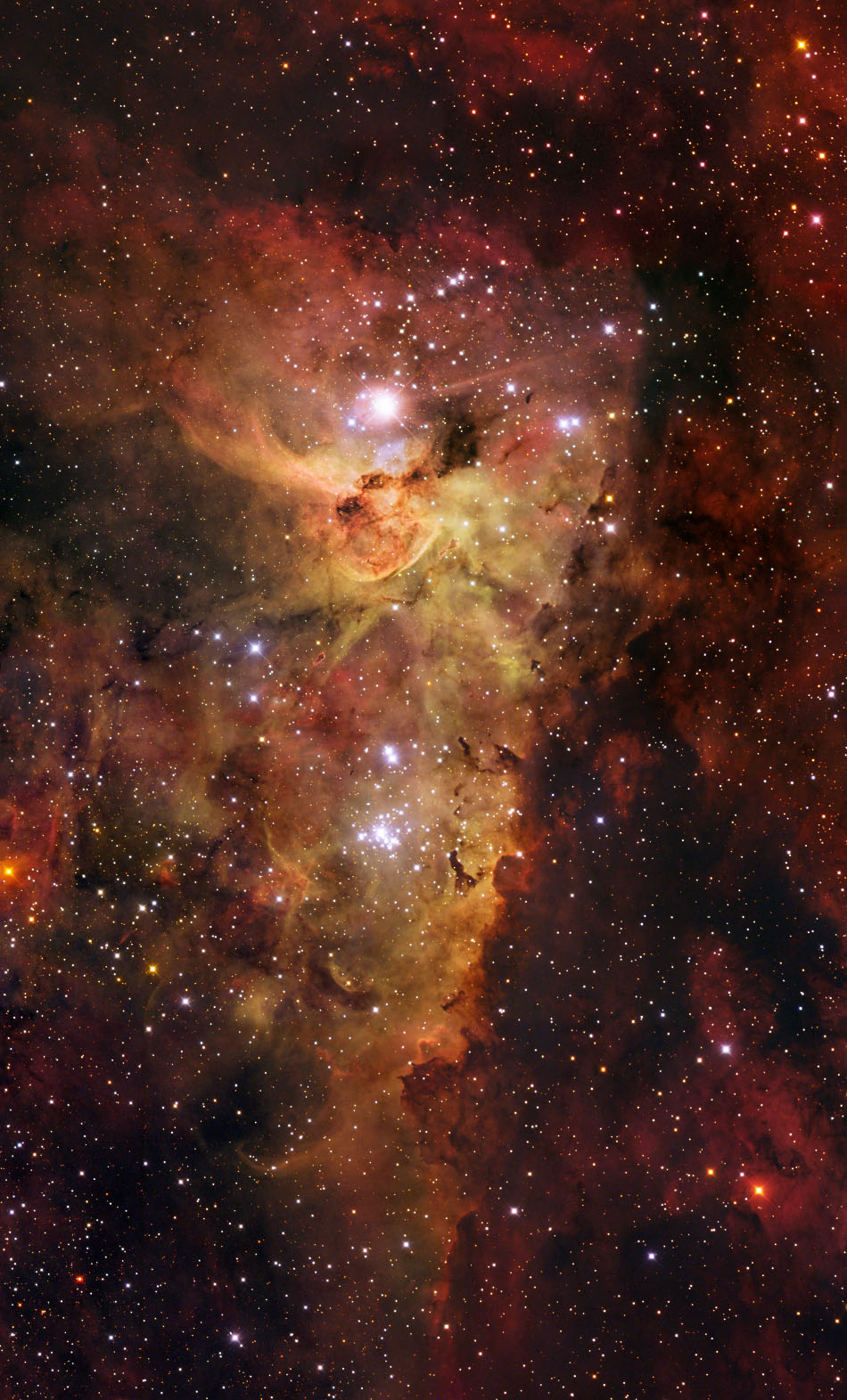
image by ESO/IDA/Danish 1.5 m/R.Gendler, J-E. Ovaldsen, C. Thöne, and C. Feron. (source)
Eta Carinae used to be even brighter and more massive, though; it is currently believed to be composed of at least two stars: a luminous blue variable ("LBV") of about 100 or 120 solar masses, depending on which source you read (and is believed to have lost an additional 30 solar masses in the past), and a Wolf-Rayet Star of about 30 solar masses; both of these types of stars are so energetic that the radiation they generate overcomes even their massive gravity, and blows their stellar material out into space in vast quantities. The combination of these stars in the Eta Carinae system has shed enough mass to form its own sub-nebula inside the 60-light-year-long Carina Nebula: the smallish but spectacular Homunculus Nebula shrouds the stars in mystery, as you can see in this Hubble mosaic combining red visible light and near-infrared, and adjusting the dynamic range so that you can see both the bright central stars and the cloud around them, which is actually 100,000 times dimmer:
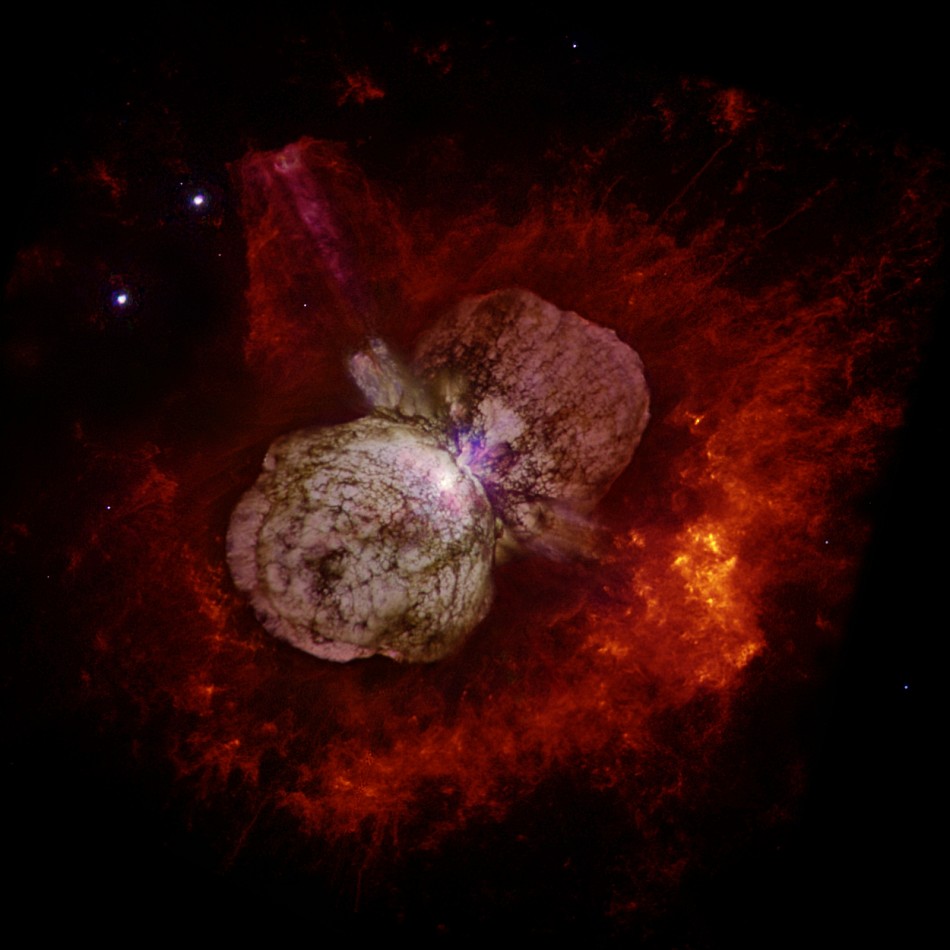
image by NASA (source)
Most of that cloud is actually thought to have come from a nova explosion in 1841; by 1843, Eta Carinae was the second brightest star in the sky--second only to Sirius, which at just 8.6 light years away is nearly 1000 times closer to us. Scientists can tell that it was an extremely powerful explosion, just short of a supernova that would have destroyed the star, due both to the amount of matter ejected in those nebulous clouds, and to their speed: they are moving outward at 1.5 million miles per hour, or 0.2% the speed of light; but that's less than half the speed of clouds expanding outward from true supernovae. Aside from that peak, Eta Carinae has gone through many cycles of dimming and brightening since its luminosity was first catalogued by Edmond Halley in 1677; these cycles are thought to have to do with fluctuations and eruptions in its stars.
In fact, some scientists conclude that the unstable star system is due for its final supernova, or even hypernova, in a "mere" 10,000 to 20,000 years. If it does eventually explode in a hypernova, it might be bright enough to be seen during the day, and its radiation could pose a threat to spacecraft and satellites in Earth orbit. If it shot beams of intense gamma-ray bursts from its poles, as can happen in such explosions, such a beam hitting Earth would subject those on the surface to 10 times the lethal dose of radiation; even if it did go hypernova, though, the chance of it happening to point its gamma ray burst directly at Earth is infinitesimally small--maybe even downright impossible, since its poles don't point in our direction. But don't let little details like that stand in the way of a good doomsday theory!
Aside from the extremely unlikely event that it might turn itself into a death ray bent on our destruction, considering that the star types making it up are very rare--there are only 20 known luminous blue variables, and only 300 known Wolf-Rayet stars in our entire galaxy--we're very lucky to have such a cool star system so close by to observe. I suppose I might not be saying that if it did explode and knock out satellites and cable TV and the internet, and maybe screw up the ozone layer a bit more than we are already doing...but come to think of it, that explosion would probably look totally rad. Besides, in 10,000 to 20,000 years, humanity will probably have way bigger problems on its hands. =p
|
·····
|
| |
| A hypernova from E=mc² in reverse | Sep 07, 2011 2:06 AM PDT | url |
| | |
Added 1 new A* page:As I was walking home from a friend's house this evening, gazing idly at the Big Dipper and imagining that I could almost see the supernova at the tip of the northward-facing equilateral triangle you can form from the last two stars in the constellation's "handle," the word "hypernova" popped into my head, so I figured I'd write something about it, because it's a pretty cool word.
A hypernova is simply the explosion of a very large--or "hypergiant"--star: one 100 to 300 times the mass of our Sun. There haven't been very many of these that have been observed well enough to make for pretty pictures, but I did find the case of SN 2006gy, which was, at the time it was discovered in 2006, "the brightest stellar explosion ever recorded" (the next year it was found to have been trumped by one that took place in 2005, but much further away--4.7 billion light years). SN 2006gy took place in galaxy NGC 1260, 238 million light years away, and seems to have been "an unusually high-energy supernova of a very large star, around 150 solar masses." Here is what its X-ray emissions looked like to the Chandra X-ray telescope: that's SN 2006gy's X-ray emissions in the upper right, and all the X-rays from the core of its galaxy in the lower left:
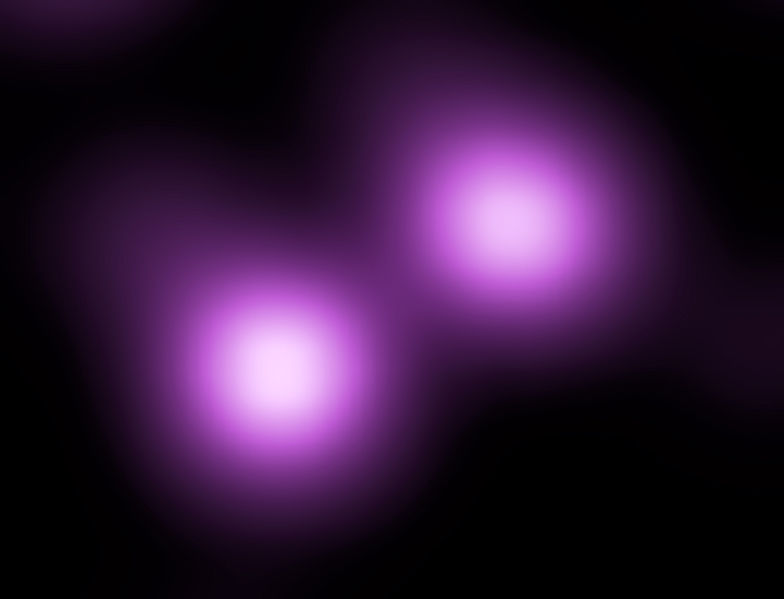
image by NASA/CXC/UC Berkeley/N.Smith (source)
So as you can see, that hypernova of a single star was almost as bright an X-ray source as the entire core of its galaxy!
SN 2006gy is also kind of interesting because scientists have theorized (among other ideas--but this seems to be the front-runner) that its explosion wasn't just the old fashioned kind of supernova, where a star runs out of fuel and collapses, with the collision of its mass resulting in a huge explosion. No! They think that it might have been the first observed pair-instability supernova, which could theoretically happen in stars of between 130 and 250 solar masses. In this case, it wouldn't have been the star running out of fuel that would have led to the explosion; instead, the star would have been in full nuclear swing, and the energy it was emitting--as high energy gamma rays--would have become so intense, due to the star's incredible size, that the gamma rays would, if they struck an atomic nucleus inside the star, contain enough energy to undergo pair production, ie turning from a huge amount of energy into matter: an electron and its opposite, a positron. Einstein's famous E=mc² in action (well, maybe specifically as m=E/c²)!
If that started happening to a lot of the star's energy output, the star would be losing heat (energy) and wouldn't have the bubbling nuclear force to hold itself up--so it would undergo partial collapse. But the sudden pressure increase of this collapse would enable nuclear fusion to burn all the star's fuel in seconds, resulting in a really huge explosion that would blow the giant star entirely apart--not even leaving a super-compressed white dwarf or black hole behind. Also,
| In addition to the immediate energy release, a large fraction of the star's core is transformed to nickel-56, a radioactive isotope which decays with a half-life of 6.1 days into cobalt-56. Cobalt-56 has a half-life of 77 days and then further decays to the stable isotope iron-56. For the hypernova SN 2006gy, studies indicate that perhaps 40 solar masses of the original star were released as Ni-56, almost the entire mass of the star's core regions. Collision between the exploding star core and gas it ejected earlier, and radioactive decay, release most of the visible light. |
|
·····
|
| |
| Aurora Borealis, the VLT, and even A* | Sep 06, 2011 1:55 AM PDT | url |
| | |
Added 1 new A* page:A very pretty time-lapse video of the northern lights:
http://vimeo.com/21294655
You may recognize the uploader there as the same one responsible for the neat video of the Milky Way spinning in the night sky that I posted a while back.
The northern lights, or aurora borealis ("named after the Roman goddess of dawn, Aurora, and the Greek name for the north wind, Boreas, by Pierre Gassendi in 1621") are what happen when charged particles from space—mostly from the Sun, I should think—zoom in along the lines of the Earth's magnetosphere and crash into the upper atmosphere at the planet's poles. There are also southern lights—"aurora australis," to use the old tongue—and you can see in an interesting superimposed video on NASA's Earth Observatory site (Quicktime format :P) that they, like their northern mirror image, form a pulsating hoop around the pole. And there are aurorae on other planets, as I've shown before, for instance here.
They are neat.
Our second video today is a time-lapse of the skies wheeling above the ESO's Very Large Telescope array high up in the mountains of Chile—lots of good views of the Milky Way:
https://www.youtube.com/watch?v=wFpeM3fxJoQ
One thing I thought was particularly nifty in that video is that you can see the VLT's laser star guide—the thin orange line—firing into the sky; it excites sodium atoms in the mesophere, about 90 km up, causing them to glow; this glow is used as a reference—an artificial star—for the telescope's sophisticated adaptive optics, which can then manipulate the incoming light from stars—or whatever the VLT is looking at—to correct for distortions caused by the atmosphere, having read the distortions very precisely from the known quantity of the light coming back from the laser-initiated glow.
But it's also fun to imagine it's shooting down incoming Klingon battle cruisers.
The supermassive black hole known as Sagittarius A*, of course, is located in the center of the Milky Way, and you could see it in that video, kinda, except that it's blocked by gas and dust, and also is probably nearly invisible a lot of the time anyway. But the VLT was one of the instruments used in the rather famous study of A* and the galactic core by the Max-Planck Institute that culminated in 2008 with this time-lapse footage showing the orbits of the stars closest to the center of our galaxy turning in tiny loops, which could only be due to the presence of a supermassive black hole—so that was pretty much the proof of A*'s existence.
Here's an ESO video sort of zooming in from a typical view of the Milky Way to those central stars. This is their article about the study and their part in it; I thought this quote from one of the lead Max Planck team members was interesting:
| The stars in the innermost region are in random orbits, like a swarm of bees," says Gillessen. "However, further out, six of the 28 stars orbit the black hole in a disc. In this respect the new study has also confirmed explicitly earlier work in which the disc had been found, but only in a statistical sense. Ordered motion outside the central light-month, randomly oriented orbits inside – that's how the dynamics of the young stars in the Galactic Centre are best described." |
And since every article needs a picture, here's a VLT photo of the galactic center in the near-infrared (the part of the infrared spectrum closest to visible light), with A* somewhere in there:
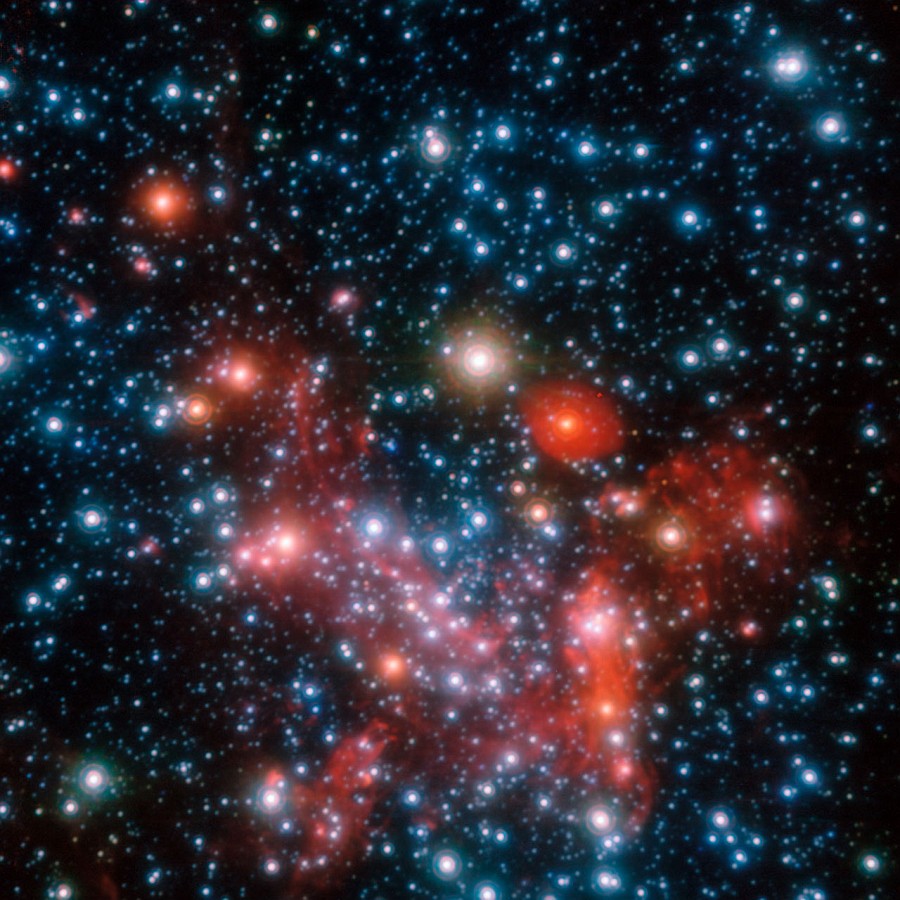
image by ESO/S. Gillessen et al. (source)
|
·····
|
| |
| A* Portraits are here! & I talk about drawing | Sep 03, 2011 4:57 AM PDT | url |
| | |
Added 1 new A* page:Since you're reading this, you may enjoy the curious way in which I draw things. You might even have wondered how actual people—maybe even people you know—would look, drawn in this way. Well, if you have $5 and a photo of the person, wonder no more! Because now there are...
A* Portraits!
(smbhax.com/portraits)
The details are on that page, but it pretty much is as simple as you sending me (over the magical Internet) a photo and five smackers, and I send back to you my version of that photo, drawn digitally fresh just for you. Here are some samples I whipped up from stock photos (they are actually pretty mundane poses, too, so hopefully some of you will send me some more interesting ones to do!):
 
I try to keep it light and quick, and they're actually pretty fun to make. So I hope you'll have something for me to draw for you!
~~~~~~~
This portrait thing came about because on Wednesday night I had a few facial proportion questions nagging at me, and I thought maybe a good way to resolve them would be to trace over some photos of faces. So I did that, trying to work over each face as quickly as possible so as not to get bogged down in boring details, and it was surprisingly fun, and the result seemed rather interesting. I think it turned out to be a more productive exercise than I had imagined it would be; since one thing I would like to be able to do for A* is to produce drawings—from scratch—that have certain photorealistic qualities, rendering some photos into my own style provided nice benchmarks as to how my drawing can have some of those qualities—while still, hopefully, looking lively, expressive, and a bit unpredictable. And it did provide a handy comparison for how facial features actually look in relation to each other, and from different angles, with my lasso drawing technique; it reminded me, for instance, that I've sort of fallen into the habit of drawing unusually small noses and lower lips—that was intentional, in the beginning, but it's rather become a habit that I'd started to take for granted.
So all in all it was a very helpful exercise, I think! I've read before of aspiring comic book artists tracing over the drawings of their favorite artists—or, come to think of it, even aspiring fine artists working painstakingly to reproduce works of "The Masters"; you come across such art students in art museums sometimes—but I always thought that sounded a little odd—like, why would you want to stick yourself with the habit of drawing in someone else's style? To learn a very specific type of brushwork or something, I suppose—but that's a rather boringly mechanical goal, if I may say so. Tracing over photos makes more sense to me, but this was the first time I'd actually tried it. I don't intend to make it a feature of my comic work—I'm always disappointed, for instance, to learn that some comic book artist I was really impressed with was relying on direct photo reference in their best work; I think there's a real danger of that becoming a crutch that limits your compositions and style—but I think maybe it has a place as an occasional exercise or refresher.
~~~~~~~~~
Speaking of other things I draw, let's not forget that my Sunday fairy tale comic, "The Princess and the Giant," will be getting a new page this weekend, as it tends to. Here's a preview/link for last week's page, to get you caught up:

Okay, have a nice weekend! I think Monday is supposed to be some sort of holiday here or something but I will probably just spend it drawing a new A* page for you anyway. :D
|
·····
|
| |
| Herbig-Haro objects animated, thanks Hubble | Sep 02, 2011 5:41 AM PDT | url |
| | |
Added 1 new A* page:One of the official Hubble Space Telescope sites, hubblesite.org, which is run by the Space Telescope Science Institute ("STScI") under contract from NASA, just released a bunch of videos that blend together Hubble photos over the years into simulated animations of some of the most studied Herbig-Haro objects; that funny name is a combination of the names of the two guys who studied them in the '40's, and realized that these little star-sized nebulae were actually being emitted from young stars: in the first 100,000 years or so of a star's life, when it is sucking in a bunch of material for fuel, some of that incoming material, often superheated, spins off—possibly along magnetic field lines, like with a black hole—and ends up shooting away from the star in a jet, perpendicular to the accretion disk around the star; so these baby stars can end up shooting two jets of energetic plasma, one from each pole.
The visible reactions mainly come when the material collides with other stuff in the larger nebula in which the baby star was born, and are often seen in bow shapes along the shock front. So these HH objects are very common in active star-forming regions, such as the Orion Nebula, which I covered pretty recently with an assembly of some amazing photos—the last one there, for instance, shows a bunch of HH objects (I called them "bow shocks and eddies and things" at the time, since "Herbig-Haro" is weird and hard to spell :P).
In fact, all but one of the HH objects in the videos above are in the Orion Nebula. Here's a handy map from *another* official Hubble Space Telescope site, spacetelescope.org, run by a European Space Agency ("ESO") group at the headquarters of the European Southern Observatory ("ESO") in Garching, Germany (jeez this is confusing!):
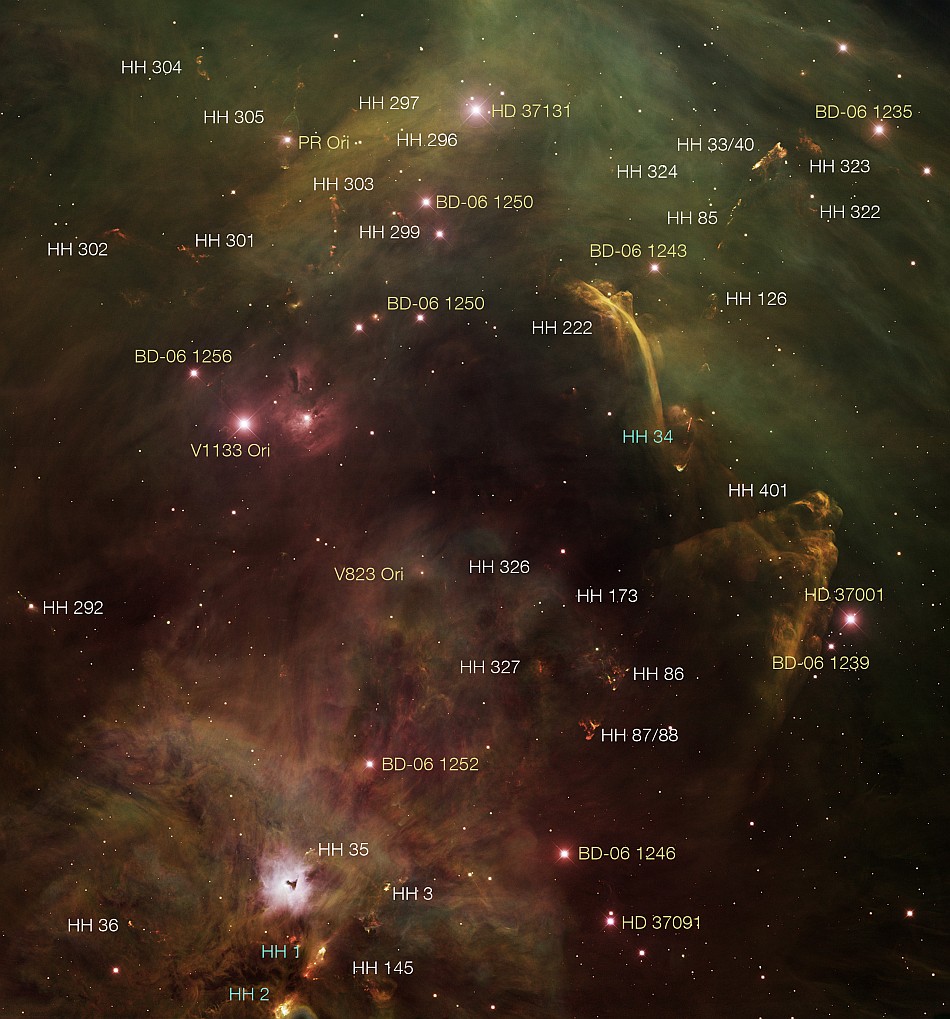
image by Z. Levay (STScI), T.A. Rector (University of Alaska Anchorage), and H. Schweiker (NOAO/AURA/NSF) (source)
That neat photo was captured by the Kitt Peak National Observatory near Tucson, Arizona. The little baby stars there are just 1500 light years away from us.
You might be wondering where HH 47 is, though! According to this hubblesite.org article, it is a 3-trillion-mile-long jet (pretty impressive for one baby star!) along the edge of the faint Gum Nebula (which is named after its 1955 discoverer, Australian astronomer Colin Stanley Gum), about 1300 light years away (a light year is about 10 trillion kilometers, or 6 trillion miles, so that jet is half a light year long!).
NASA has a bit more about the movies in their article here, in particular mentioning the curious clumpy nature of the jets, which suggests the accretion and shooting off of material is not a steady process. Note though that this same animating thing has been done before with these HH objects, for instance in the Flash montages here—although those only go to 2007 rather than 2008, and don't really try to simulate the movement of the plasma between photos in great detail.
~~~~~~~~
On a semi-related note, I added a "hubblevid" tag to the forum for embedding hubblesite.org videos; their embed format isn't the easiest to work with though, and I suspect it will probably break if the site ever upgrades to a larger video size. :"P
|
·····
|
| |
| Death of a comet, a star, and bye-bye Earth | Sep 01, 2011 1:19 AM PDT | url |
| | |
Added 1 new A* page:Recent space news happenings!
~~~~~
The comet Elenin, (or C/2010 X1, if you like) just discovered by an amateur Russian astronomer last year, appears to have disintegrated; observers report its core has become "elongated and diffuse," and in the past week it has declined in brightness by 50%. The sun-watching STEREO-B satellite had been tracking Elenin as it neared the Sun, and captured this video on the 19th of August, in which Elenin, I think the brightish dot in the middle, appears to be hit by a coronal mass ejection--you can see an abrupt increase in material coming off the comet:
video on Youtube
If it is breaking up, it wouldn't be an entirely unusual occurrence for comets flying into the hot mouth of the solar wind; this was observed to happen to comet C/1999 S4 (LINEAR) back in 2000, for instance. Elenin is due to reach perihelion--its closest point to the Sun--on September 10th, when it will be 72 million km (45 million miles) from the Sun; that's about midway between Earth's orbit and the Sun, and just a little further away from the Sun than the orbit of Mercury.
Elenin had been estimated by its discoverer, Leonid Elenin, to be about 3-4 km in diameter, and it had been expected to loop back toward Earth, coming within 35 million km (22 million miles) of our planet on October 16th. That isn't really very close ("slightly closer than the planet Venus") but it didn't stop a number of doomsday predictions being made in relation to the comet! :P Elenin would have been far too faint to see with the naked eye even if it had been intact at its closest approach, but now it's an open question as to just how much--and in how many pieces--of the comet will be left when gravity brings it back around.
~~~~~~~~
NASA's recently launched Jupiter probe, Juno (remember, it's the one that launched on August 5th, with the custom LEGO figures on board), on its way to the giant planet, turned its camera around and captured this photo of the Earth and Moon together, as seen from about 10 million km (6 million miles) away:
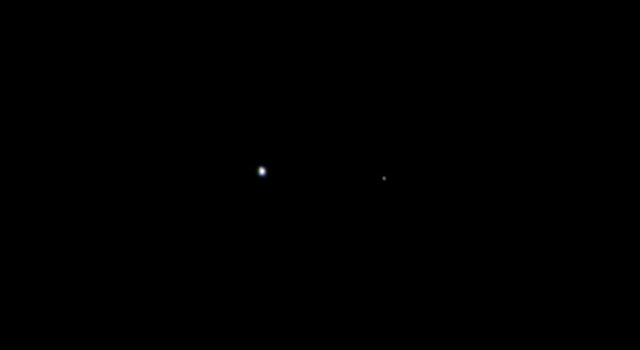
image by NASA (source)
And for some more perspective on the distances involved, NASA JPL's article on the photo adds: "Juno covered the distance from Earth to the moon (about 250,000 miles or 402,000 kilometers) in less than one day's time. It will take the spacecraft another five years and 1,740 million miles (2,800 million kilometers) to complete the journey to Jupiter."
~~~~~~~~
On the 24th, the Palomar Transient Factory, a project at California's Palomar Observatory described as "an automated telescopic survey that scans the sky for transient and variable astronomical events," detected SN 2011fe, a white dwarf star 21 million light years away in Messier 101, aka the Pinwheel Galaxy, undergoing a supernova explosion. "It was observed by the PTF survey very near the beginning of its supernova event, when it was approximately 1 million times too dim to be visible to the naked eye. It is the youngest type Ia ever discovered. [...] One day later, on 23 August 2011, it was 10 thousand times too dim. On 24 August 2011, it was 6 times brighter than that. It is expected to be visible with strong binoculars within several weeks of discovery."
Here's how the supernova looked to one astronomer on the 25th:
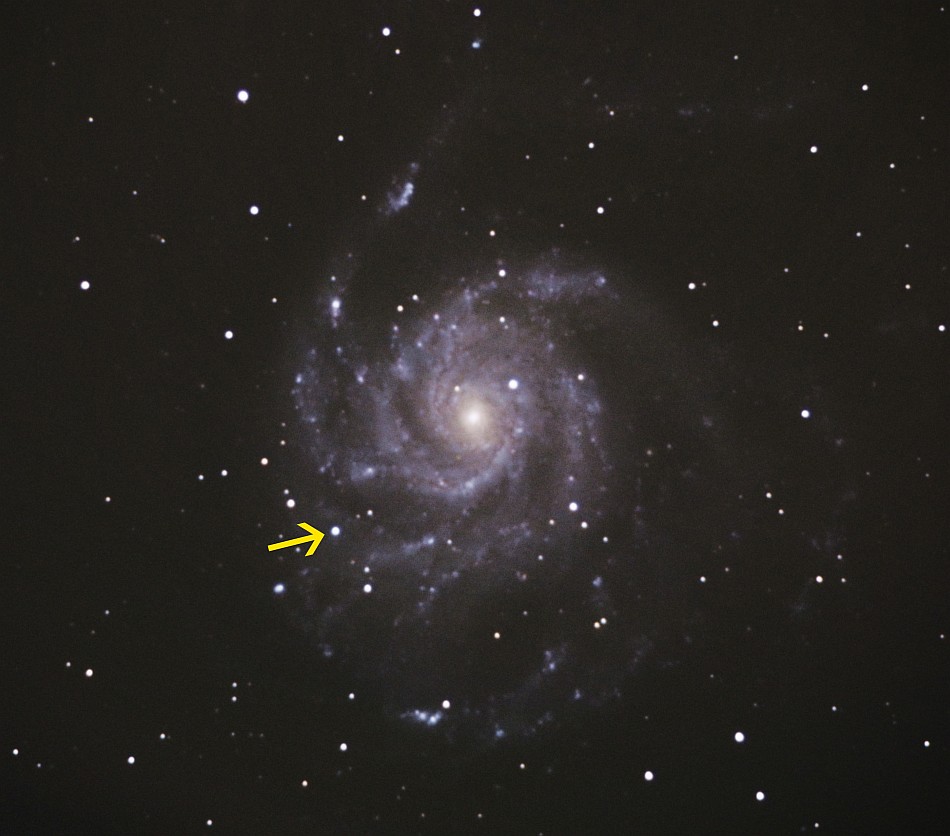
image by Thunderf00t (source)
A type Ia supernova is the supernova of a white dwarf star; these events are very important to astronomers, because the exploding stars are thought to have a nearly uniform mass: nearly 1.38 solar masses, aka the Chandrasekhar limit, the point at which a white dwarf's nuclear reactions could no longer support its own weight, and it would collapse, triggering a supernova.
Actually, though, it is now thought that the Chandrasekhar limit is never quite reached; instead, when the accreting white dwarf star, which is usually a cooling, electron-degenerate (so dense that its atoms are squeezed tightly together, held apart only by their orbiting electrons) mass of carbon and oxygen left over from the death of a small to medium-mass star, gets within about 1% of the limit, a period of convection--internal currents, I guess--begins, lasting about 1000 years. At some point during that relatively brief time, its carbon, and then its oxygen, begin to undergo nuclear fusion; the incredibly dense carbon/oxygen material making up the star fuses into heavier elements in just a few seconds, releasing more than enough energy to blow the star apart as a supernova.
Anyway, because they occur at pretty much exactly the same size, this type of supernova also has pretty much exactly the same brightness, "about 5 billion times brighter than the Sun." Their brightness to an observer on Earth, then, varies more or less only by how far away they are. To an astronomer, this means that if they spot one, all they need to do is measure its brightness, and they'll know how far away it is, making them very handy for getting highly accurate readings of distances to other galaxies, and so forth. It was an analysis of type Ia supernovae, for instance, that convinced the science world in 1998 that the universe is expanding at an increasing rate (that was the follow-up to Edwin Hubble's 1929 discovery, based on an analysis of the redshift of various galaxies, that more distant objects are moving away from us more rapidly, ie that the universe is expanding).
So, because SN 2011fe was found so early in its explosive life, and because it is so close, relatively, astronomers studying it should be able to refine their measurement of the mass, luminosity, and other characteristics of these supernovae, which in turn will enable them to make more accurate estimates as to the expansion and mass of the universe--perhaps getting us closer to certainty on some fascinating and ultimately important questions such as what comprises the parts of the universe we can't see, and what is our universe's ultimate fate.
|
·····
|
|
|
